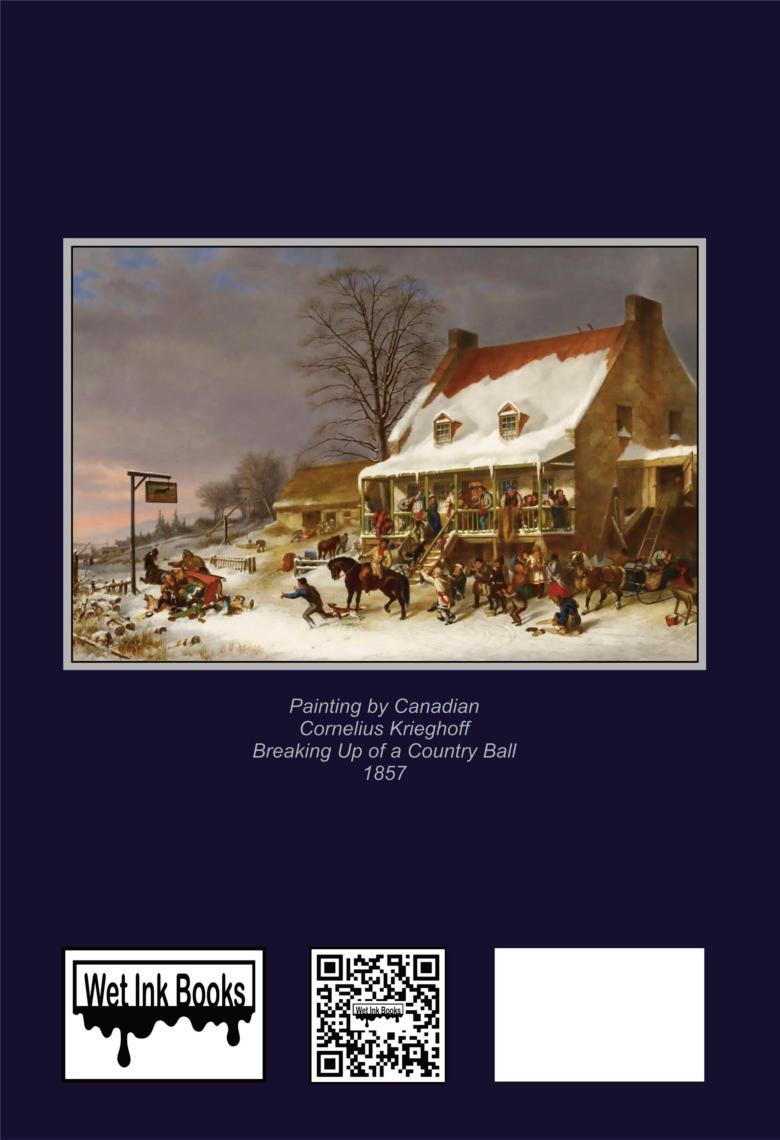




Find some of Canada’s finest authors, photographers and artists featured in every issue.

2018
is to promote Canadian culture by bringing world-wide readers some of the best Canadian literature, art and photography.
Devour: Art and Lit Canada
ISSN 2561-1321
Issue 019
Winter 2024 / 25
5 Greystone Walk Drive Unit 408
Toronto, Ontario, Canada, M1K 5J5
DevourArtAndLitCanada@gmail.com
Poetry Editor – Bruce Kauffman
Review Editor – Shane Joseph
Photography Curator – Mike Gaudaur
Front Cover Art – Kent Monkman
Back Cover ART – Mike Gaudaur
Editor-in-Chief – Richard M. Grove
Layout and Design – Richard M. Grove
Welcome to this 19th issue of Devour: Art & Lit Canada. As usual we are bringing you some of Canada’s most talented writers, poets, photographers and artists. Aside from the regular feature sections this issue brings you, Miss Chief Eagle Testickle, the alter ego of Kent Monkman, in the fictional memoir entitled, The Memoirs of Miss Chief Eagle Testickle written by Kent Monkman and Gisèle Gordon. This Indigenous content will make you smile as well as furrow your brow.
We hope you will tell your international readers about this all Canadian Magazine.
Enjoy this all Canadian content.
Richard M. Grove otherwise know to friends as Tai


– Canada Coast to Coast to Coast –
Photography Curator – Mike Gaudaur – p. 8 – 13, 123
– Feature Photographer – Margaret Liddon – p. 14
Photographs on pages – 14 - 18
– Canada in Review – Editor – Shane Joseph – p. 19
– Indigenous Canada – ᐃᐦᑭ / IHKE / MAKING/ART
Curtor – Debora Puricelli – ᑌᐠᕑᐊ
– p. 30
A Review and Commentary on: The Memoirs of Miss Chief Eagle Testickle by Kent Monkman and Gisèle Gordon –Review Essay by Richard M. Grove – p. 32
– Poetry Canada – Editor – Bruce Kauffman – p. 46
– An Essay on Allan Briesmaster’s book of poetry Windfor.
– Review Essay by Richard M. Grove – p. 92
– Language and Themes in April Bulmer’s Good Grief
– Review Essay by Prof. Miguel Ángel Olivé Iglesias – p. 99
– Good Grief by April Bulmer
– Review Essay by Richard M. Grove – p. 104
– Time, and Time Again A Review of rolling through time by Dinh Le Doan
– Review Essay by Prof. Miguel Ángel Olivé Iglesias – p. 106
– An Essay on Shane Joseph’s Novel Victoria Unveiled
– Review Essay by Richard M. Grove – p. 110
– An Essay on Fathers & Sons
– Review Essay by Prof. Miguel Ángel Olivé Iglesias – p. 117
Photography Curator Mike Gaudaur
After more than four decades of making images that show what something looks like, I am gradually shifting towards making images that show more of what things feel like. I find that the images I capture are more graphic and minimalist. However, I think it is my processing of images that is changing even more. I am less concerned about ensuring that every little detail is clear and sharp, and more concerned about enhancing a mood and

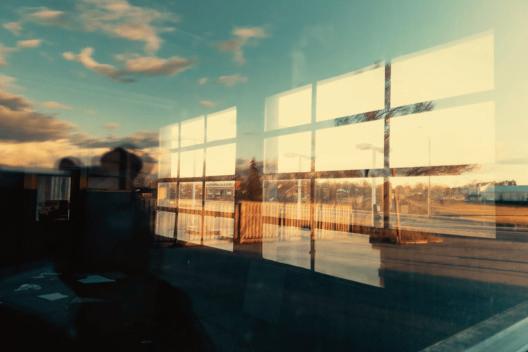
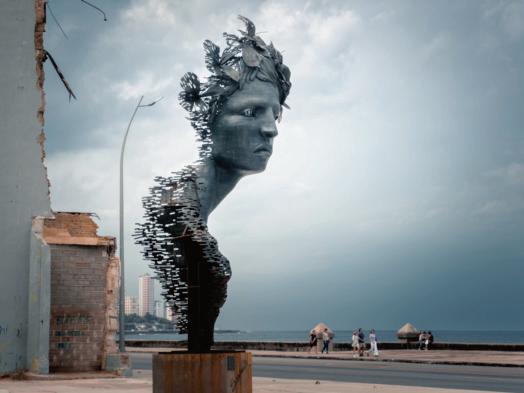
guiding viewers to see just what it was that caught my eye with nothing to distract them. With this collection of images I have been experimenting with colour grading that shifts tones to enhance mood.
Mike has spent the past 12 years teaching photography during school terms and photographing on safari during the term breaks. Online training and countless late nights of experimenting resulted in Mike developing a full complement of digital skills. After returning to Canada he was able to formalize his training and become an Adobe Certified Expert in Photoshop. Mike is a never ending learner, experimenter, explorer. His learning didn't stop with Photoshop. He naturally grew into working with Lightroom, On 1 Perfect Photo Suite, and the Nik Software collection. His advanced skills in the digital technology have allowed him to push his photographic style even further.
You can find mike at: https://www.mikegaudaurphotography.com/ or contact him by email at, mike.gaudaur@gmail.com


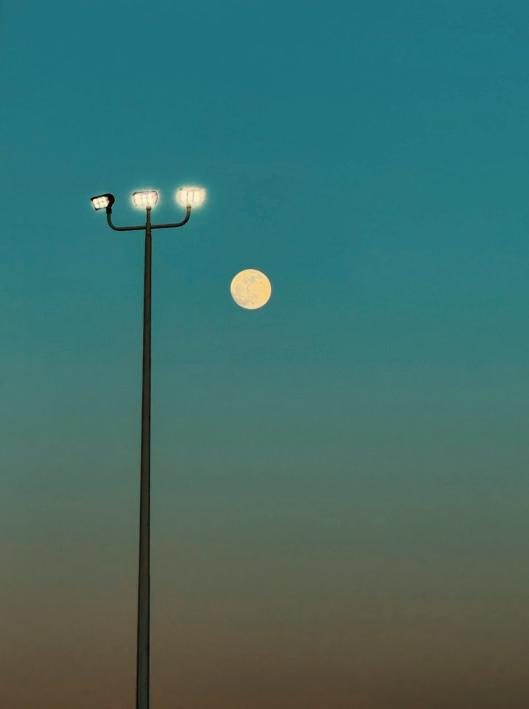
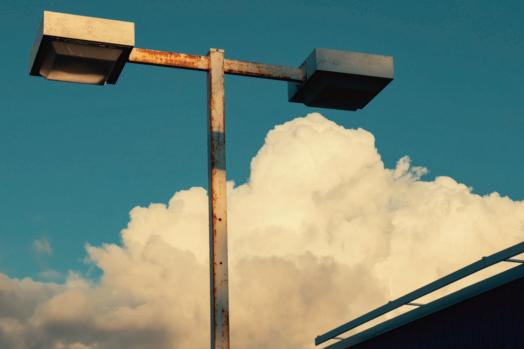
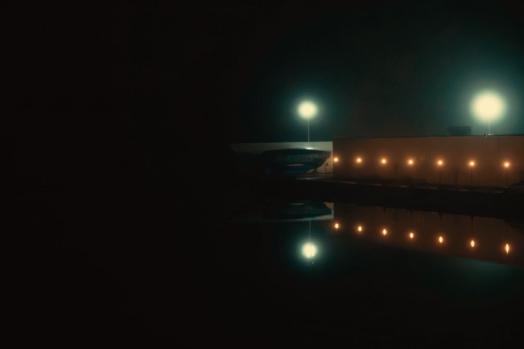







Margaret Liddon Hoodoos-Drumheller Alberta
Photography provides Margaret with an important outlet for her creativity. She is a frequent speaker on elements of art composition and creative photography. Margaret is a founding member of the Prince Edward County Photography Club and plays an active role on its Executive Committee.
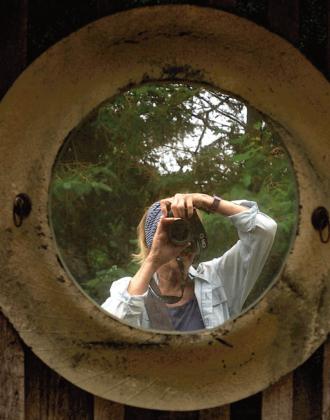
Born in Dublin Ireland, Margaret comes from an artistic family. She is a graduate of Sheridan College where she studied art & photography as part of her Interior Design designation.
Margaret lives on the Bay of Quinte in Prince Edward County, Ontario and enjoys travelling across Canada and other countries for photographic opportunities. She has particular interests in architectural and landscape imagery. Her work is currently on display at the Arts on Main Gallery in Picton.
“I enjoy both the power and the challenge that the camera provides to the artist to isolate subjects from their often cluttered surroundings and thereby make a statement about the subtleties of our natural world.”


Shane Joseph


Book Editor’s Note:
In this Summer Edition we delve into memoir and poetry, leaving fiction for the Fall/Winter.
The memoirs of Tomson Highway, Lola Reid Allin, and Stuart Ross speak to lives forged against adversity. Tomson takes us past the stereotype of colonialism to propose that he actually benefited from the “system” despite wearing its scars. Lola busts the female stereotype by soaring to heights in the world of aviation. Stuart shows us a way through grief and the loss of loved ones with his inimitable sense of humour – when in doubt, have a hamburger!
The poetry breaks out into two streams: Dinh Le Doan portrays the magic of nature, and Gail Murray’s reminiscences of life—especially of the men in her life—and events that shaped her, are rendered with grace, humour, and detachment.
A collection to contemplate and be enlightened by, I hope you choose some, or all, of these books for your summer reading.
Shane Joseph
Book Reviews Editor
Author: Lola Reid Allin
Publisher: She Writes Press/Simon & Schuster
ISBN: 9781647428006
Number of Pages: 344
Published Year: 2024
Reviewed by: KC Finn


Highway to the Sky: An Aviator’s Journey is a work of non-fiction in the memoir, slice-of-life, and social commentary genres. It is best suited to the adult reading audience owing to moderate references to sex and violence and some use of strong language. Penned by author Lola Reid Allin, this heartfelt book chronicles the author’s remarkable odyssey from a childhood dream crushed by societal norms to becoming a successful pilot in a maledominated industry. Despite facing familial discouragement and societal pressure to conform to traditional gender roles, Lola’s passion for flying drives her to defy expectations and pursue her dreams. From navigating toxic relationships to confronting discrimination and hostility in the aviation world, Lola’s journey is a testament to resilience and determination. Her memoir transcends genres, blending personal challenges with professional aspirations, and offers a poignant reflection on the importance of pursuing one’s passions in the face of adversity.
Lola Reid Allin has crafted a candid narrative that sheds light on the struggles faced by women in male-dominated industries, offering a great balance between her personal experiences and an extended social commentary on modern life. Her journey from a childhood marked by discouragement to finding fulfillment as a pilot is both empowering and relatable, and the pacing of her storytelling as she recounts her life is detailed and engaging. I was particularly moved by Lola’s resilience in the
face of adversity as she navigated toxic relationships and confronted systemic discrimination with unwavering determination. The speech and thought presentation to recount these encounters is readable and compelling, with strong characterization of those antagonistic forces that she meets along the way. The memoir’s exploration of societal expectations, gender norms, and the pursuit of personal fulfillment resonated deeply with me, prompting reflection on my own experiences and the importance of resilience in the face of challenges. Overall, Highway to the Sky is a compelling testament to the power of perseverance and the pursuit of one’s dreams, offering inspiration to readers facing similar struggles in their own lives.
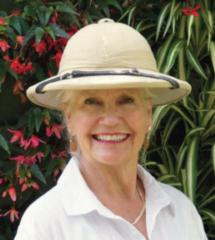

Lola Reid Allin is an Airline Transport Pilot, flight instructor, SCUBA Dive Master, and an award-winning author and photographer whose work has appeared in many notable publications including National Post, Globe & Mail, and National Geographic, and in national and international juried shows. Lolareidallin.com
Playwright and performer K.C. Finn is an Amazon and USA Today bestselling author. Since 2011, his unique and diverse voice has garnered many awards for stories, poems, and novels which span many genres, including fantasy, science fiction, gothic fiction, horror, paranormal, and historical. Kcfinn.com
Author: Tomson Highway
Publisher: Doubleday Canada
ISBN: 9780385696203
Number of Pages: 344
Published Year: 2021
Reviewed by: Shane Joseph


Tomson Highway’s memoir of his life from birth to graduation from residential school is a refreshing departure from the stereotypical literature we have been exposed to in recent times about the evils of colonialism. Here is a Cree of fluid gender who thrived in that world and went on to become a world-famous musician, playwright, and writer and who looks upon his past with love and fond memories instead of regret.
Life in the sub-Arctic was harsh for parents Joe and Balazee Highway, who lost five of their 11 children. Many died from exposure during the family’s nomadic travels between the islands of Reindeer Lake for fishing and hunting. Many, like Tomson, were born in snowdrifts, while siblings like his 12-year-old sister Louise was sent out into the night to get help.
There is also a huge opportunity gap between the older siblings and the younger ones as technology advanced. Louise took a month to travel oneway to her school in the Pas and only lasted until Grade 2 while Tomson was flown by float plane from his home base in Brochet, MB to his residential school in Clearwater Lake, and went onto a full education.
The chapters alternate between the family’s peripatetic life in the arctic and Tomson’s life in the residential school. Tomson navigates both worlds well, after a shaky start at the latter, where he has to learn the practices and customs of white Canadians and the English language. He introduces us to translations of Cree and Dene words into English and vice versa. He introduces all his school friends and acquaintances by name and place of residence—like “Jesus of Nazareth” — even in the heat of a fight or game. He also goes onto explain the differences between Status and Non-Status Indians. The former were given the largess of an all-expenses paid education, replete with uniforms, transportations, food and board, sports
facilities and equipment, but could not join the armed forces, drink alcohol, or vote in Federal elections, and they had to remain on the reserve – seems like a waste of all that money, if integration was the desired end game.
Tomson’s delivery is funny. Using a Biblical syntax at times, where subject follows verb, and complex sentences that got me lost, he treats the reader to a multitude of anecdotes: dogs mating in front of a mass ceremony; the Big Boys sneaking into the Big Girls dormitory at night for you-know-what and getting caught; the church converted to a movie theatre and deteriorating into wild-west style brawl on film night. There are poignant moments too: Joe Highway’s struggle through a snowstorm, where he ends up asleep, allowing his dogs to take him home; the Arctic tern egg-hunt; brother Swanson’s wedding at a fishing camp where the ceremony never ends.
Tomson in unafraid to deal with the sexual abuse that gained the residential schools notoriety: Father Lemoine, Keeper of the Middle Grades, who “does” four boys a night for over six years, Tomson being one. However, our boy transcends the abuse with “why dwell on the past when there are so many people to love and be loved by?”
He is cheeky with nick names, lavishly conferring them on indigenous and whites alike: Gunpowder, Meat Toss, Bad Robber, Happy Doll, Watermellon were some names that stuck for his fellow villagers; Mrs. Permafrost (for Permachuk), Fr. Egg Nog (for Egenolf) and Asslick (for Angelique) bring up the white side. He also admits that his own name was spelled thus and not as Thompson or Thomson because Father Egg Nog’s English was poor when entering the baby’s name in the baptismal register.
This is a good primer on Indigenous life by one who straddled both worlds and who harbours ill-will towards no one, but who is grateful for the blessings showered upon him and his family despite the hard times they lived through.
In the six decades since he was born in a tent in the bush of northernmost Manitoba, Tomson Highway has traveled many paths and been called by many names. Residential school survivor, classical pianist, social worker and, since the 1980s, playwright, librettist, novelist and children’s author. In 2000, Maclean’s magazine named him one of the 100 most important people in Canadian history.

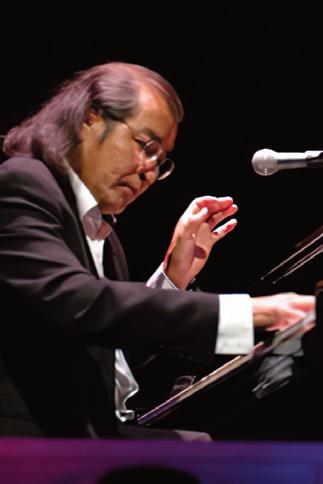
Shane Joseph is a Canadian novelist, blogger, reviewer, short story writer, and publisher. He is the author of eight novels and three collections of short stories. His latest novel, Victoria Unveiled, will be released in the Fall of 2024. For details visit his website at www.shanejoseph.com
Author: Gail M. Murray
Publisher: Blue Haven Press
ISBN: 9781739059163
Number of Pages: 115
Published Year: 2024
Reviewed by: Liz Torlée

In Reflections and Reveries, Gail Murray takes us on a magical mystery tour, through the lush landscapes of the Mediterranean to the “clang and clutter” of New York, from sunny memories of childhood, through roller coasters of love, to musings on the approach of death.

Murray writes in free verse style, with none of the traditional meter, rhyme or stanza formatting. Instead, the words flow unfettered by convention, sometimes grouped into three or four lines, but more often filling whatever space they need: I search out beauty/ crafted with a gentle heart/ Sometimes the poetry chooses me (Inspiration)
The poems rooted in the love of nature are classically beautiful. They bring out the author’s deep respect for the natural world, and engage all our senses: Here in the clouds, the air clean/ Layers of green bathe my winter weary spirit (Rainforest). Whether telling us of the orange groves of Grenada, or the “thunderous explosions” of Costa Rica’s Arenal volcano, Murray taps into the emotional power of Mother Nature and pulls us close to share her secrets.
Sometimes, the author takes us closer to travel writing or descriptive prose style — hiccups in the otherwise seductive read. The poems Genoa (Today the highway obstructs our view/ Guidebooks don’t tell you that), and Packing with its practical advice, are examples of this. But, we are soon brought once more under the spell of emotional contemplation. Her writing is deceptively simple, grouping common thoughts and feelings in unusual ways, bringing new depth of feeling, new light on old subjects. I can’t move on till/He moves out /out of my mind/ out of my reveries/ off my phone line (Out There). In Twilight in Barbados, a particular favourite of mine, the author paints a simple but
captivating scene, conjuring sight, smell and sound so clearly into twelve short lines, ending with guests in their rooms/ shower away salt and suntan lotion/ I sit at peace/as the resort comes to life again.
Murray covers a broad canvas with this work, including recollections of long-ago family gatherings, men gone to war, tributes to long-deceased authors and feline companions, as well as the challenge of inherited memorabilia that inspire reverence and despair. What’s to become of these treasures? Oh well, at least I’ve used the good dishes. (It’s Time.)
But it is the poems about love and its loss that resonate most profoundly. Some zero in on the delicious anticipation at the beginning of a new relationship… the sweetness and excitement of/ yet to be/ beckons (Response), and When he departs/ A part of me goes out the door/ with him (My Split Apart). Many are suffused with regret, and reveal a deeply honest vulnerability, a harrowing sense of betrayal: From the admission of your affair/ you long for it, too/ just not with me. (Remember How), What is he telling me? “…had an encounter … she can arouse me.” Traded in like a used car. (Blindsided), and If you meet a year from now/ How will you feel?/ Will you feel at all?(Orchid Petals)
Particularly poignant is Living on Hold, touching on life during the pandemic, and echoing feelings that so many endured during this time: She lives on hold, growing older by the minute/ running out of time to love again.
No matter what the theme, lovers of poetry will find themselves happily lost in these one hundred and eleven reveries and reflections, losing track of time as they explore and succumb to the embrace of this highly creative new work.
Gail Murray is a former English teacher and librarian focused on drama and literature. She is a widely published freelance writer who lives in Toronto, and enjoys hosting friends in her perennial garden. Her poems have been published in Written Tenfold, Blank Spaces, Wordscape, Arborealis, The Banister, and on CommuterLit.com.


Liz Torlée has two novels published by Blue Denim Press: The Way Things Fall (2020), and In Love With The Night (2022), and is currently at work on the third in the trilogy. Her short story, “Flight”, was published by Chicken House Press in the anthology, Will There Be A Sunset? in April 2024.
Author: Stuart Ross
Publisher: ECW Press
ISBN: 9781770416567
Number of Pages: 152
Published Year: 2022
Reviewed by: Shane Joseph
A lot of people get sick and die in this book. In fact, I’m wondering whether to cross the street when I next see Stuart Ross walking around our small town, in case he unwittingly puts the hex on me.


Stuart chose to write this book on grieving during the pandemic, which begs the question of whether that mournful period of isolation added to the pathos in his pen. He admits he is “a sad-sack who feels only melancholy longing,” – well, he certainly picked a great time to amplify his loss within the pages. That said, the writing flows, and Stuart’s engaging, selfdeprecating style hooks the reader. It’s easy to take this sad trip with him.
A book about hamburgers and grief – two unlikely travelling companions on the road of life. We soon realize that the hamburger is not a metaphor but a device, a safety blanket for Stuart to hang onto and distract himself when things get emotionally heavy on the grief side. As for the grief, he seems to have bottled it up, writing two or three-page essays that fill this book to avoid confronting the real enemy. He wants to grieve. He is like a man suffering from Griefstipation, if I can coin a poetic word. So, he thinks of hamburgers instead, and that helps, temporarily. In between hamburgers and grief, he reminisces about all the people he has lost in his life, beginning with his mother in 1995, brother Owen in his mid-forties, father a few years later, and finally brother Barry during the pandemic, and a whole slew of his poet friends and mentors. All dead. He is the last man standing and it is frightening for him.
Scenes of dying, and how they died, play out in a repeating groove, and I wondered whether Stuart was doing this for effect or catharsis. Yes, we all had people die during the pandemic – I had three myself – mother, brother,
and father but coming from the Third World, I had no option but to get up, dust off, and keep marching. Was Stuart replaying a First World boomer response to death and dying? Something that was not supposed to happen, despite parents coming through the Holocaust and WWII? But as he rightfully observes, we all grieve differently, and for some of us, grief is permanent. And some of us prefer to eat hamburgers all the time and not look within.
To his credit, Stuart stops talking about hamburgers in the last few sketches and lives through the death of his close friend Michael Dennis, while isolated during the pandemic. He introduces us to the backroom scene of a MAID procedure of another friend where the attendant doctor shakes the dead man to see if he is still alive and then bursts into tears. Stuart talks of the craving “for one last time with the loved one,” something we all long for in retrospect. And he openly professes his love for the departed, something many of us have difficulty with – hamburgers are easier.
Reading this book, I also got a deeper appreciation for the lives of poets. These guys write poems to each other and collaborate on work during marathon all-night sessions that produce up to twenty poems a night! While we novelists don’t want to have anything to do with our peers while we work, preferring to sit solitary in our garrets and write the masterpiece that doesn’t come.
I applaud Stuart for tackling this difficult subject and for laying himself bare for the world to see his tears and feel his angst. Maybe after he reads this review, he might see me hurrying to cross the street and call me over to go have a hamburger with him, even though he’s a vegetarian.
Stuart Ross published his first literary pamphlet on the photocopier in his dad’s office one night in 1979. Through the 1980s, he stood on Toronto’s Yonge Street wearing signs like “Writer Going To Hell: Buy My Books,” selling over 7,000 poetry and fiction chapbooks. In spring 2023, Stuart received the biggest book award in Ontario, the Trillium Book Prize, for his memoir The Book of Grief and Hamburgers. Stuart is currently working on ten book projects.


Shane Joseph is a Canadian novelist, blogger, reviewer, short story writer, and publisher. He is the author of eight novels and three collections of short stories. His latest novel, Victoria Unveiled, will be released in the Fall of 2024. For details visit his website at www.shanejoseph.com.
Author: Dinh Le Doan
Publisher: Wet Ink Books
ISBN: 9781998324101
Number of Pages: 94
Published Year: 2024
Reviewed by: Jennifer Lynn
Dunlop
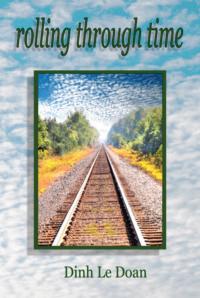
Dinh Le Doan masterfully captures the essence of nature’s dialogue in his evocative verses. I believe the most engaging aspect of poetry is to enable us to feel deeply, to perceive differently, and to emerge changed. Le’s poetry allows this insight. His succinct writing solicits full and complete participation in his images. In “Outside Inside,” he delicately orchestrates a symphony between water and sky, seamlessly transitioning from day to twilight, each line a brushstroke in the canvas of the mind: Water continues its glimmering / conversation with the sky until twilight. / The day’s job is done.

The concept of a ‘glimmering conversation’ alights my imagination with possibilities and images.
“Sights and Sounds at Lake Renaud” transports the reader to the serene embrace of nature, where a lone red canoe punctuates the verdant expanse such as a vibrant note in a tranquil melody. Le’s imagery is not merely seen but felt, resonating with profound depth and introspection: And amidst all this green from shore to shore / a red canoe rests – a red dash placed / for special emphasis in the midst / of a green poem
The interplay of sound and sense reaches its zenith in “Landscape of Abandonment,” where the lake, in its wintry slumber, closes its heart and door to migrating birds. Here, Le’s words are not just descriptive but poignant reflections on the cyclical nature of existence: Migrating birds stop / dropping by the lake when it closes / its heart and door.
“Winter Morning at the Lake” unveils a world where morning descends from the trees in playful descent, while houses peer out with gleaming eyes
and metal chimneys sparkle like jewels in the dawn. Le’s language dances with nuance, inviting readers to rediscover the beauty in the ordinary: Morning playfully climbs down the trees / of the opposite western shore / Houses flash their eyes. / Metal chimneys glitter.
In Le’s poem “After the Heavy Summer Rain,” he paints an unforgettable picture: The cottage dock / dips its flat beak into the lake and drinks / to its heart’s content.
He equates the dock to a bird drinking. I have viewed many docks in my life but never has this image crossed my mind before. It is a testament to Le’s imagination and creativity.
In “Kayaking in May,” Le breathes life into the inanimate, as the kayak becomes a companion with thoughts and opinions, reshaping the narrative of the journey. Here, the boundaries between the self and the natural world blur, inviting readers into a realm of boundless imagination.
“Sketch of April” concludes with a poignant reminder of life’s immutable essence, where shingle roofs glisten in the rain, and the everchanging sky whispers of the inevitability of change. Le’s words linger like echoes in the mind, offering solace and insight in equal measure.
In each poem, Le crafts a tapestry of time and transformation, weaving together the threads of nature and human experience with consummate skill. His poetry offers a doorway into an alternate dimension of animate objects, the epiphanies of nature, and thought-provoking images. His verses are not mere observations but revelations, illuminating the interconnectedness of all things in a world brimming with beauty and possibility.
Dinh Le Doan lives in Beaconsfield, Québec. He has a PhD in engineering from the University of New South Wales in Sydney, Australia, and has worked since 1978 in the Canadian space industry as an engineer and manager. During his retirement he devoted his time to writing poetry. “rolling through time” is his first book of poems.

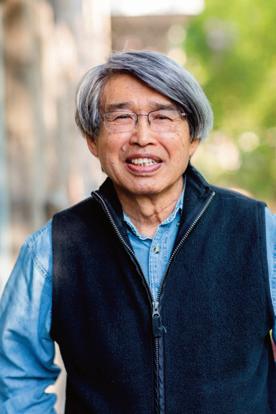
Jennifer Lynn Dunlop is a Professor at Fanshawe College and a Manager at Wilfrid Laurier University. She is the Past President of the Tower Poetry Society. She is a poetry judge for the Hamilton Poetry Contest: Power of the Pen. She has had over a hundred poems published in multiple books and anthologies.
ᐃᐦᑭ is the phonetic spelling of “IHKE” in the Indigenous language. IHKE” is the root word of “Make” in the Indigenous language.
Debora Puricelli
Biographical Note for Debora Puricelli –
débora ᑌᐠᕑᐊ puricelli
graduated from the Indigenous Visual Culture Program at OCADU in 2018. She received the Bronze award for Highest marks in Liberal Arts and Sciences as well as the award for Highest achievement in the INVC (Indigenous Visual Culture Program). She was also given the title of “Knowledge Keeper” or “Knowledge Holder” by the Ojibwe/Cree Elders, Edna and Connor.


Hello and welcome to the Summer 2024 issue, Indigenous ᐃᐦᑭ / IHKE / MAKING/ART section of Devour: Art & Lit Canada. My name is débora ᑌᐠᕑᐊ Puricelli ᐳᕑᐃᐨᐁᓫᓫᐃ, I would like to welcome the visionary artist Kent Monkman and his ally and cowriter Gisèle Gordon. First off I have tried to pinpoint what draws me to the world of Miss Chief Eagle Testickle and I feel like it’s ‘Life’ and/or ‘Alive’. The vibrant colours, the historical and modern references which keeps Miss Chief Eagle Testickle in her unique place.
That said I would like to share the fact that many people still think of Indigenous as historical but I say the past is Indigenous and the future is too, but most importantly the now is Indigenous. Miss Chief Eagle Testickle is in the Now. Miss Chief Eagle Testickle stands with the Land through the window of time. Miss Chief Eagle Testickle is the humble and gentle and loving Now. Miss Chief Eagle Testickle challenges the truth of colonial thought. For Miss Chief Eagle Testickle the colonial are also in need of her Land based knowledge, colonial thoughts need Miss Chief Eagle Testickle's help to survive because the Land invites Miss Chief Eagle Testickle to herself and works through her to survive.
I remember going with my friend to see Kent Monkman's Show at the Textile Museum here in Toronto and I feel like there’s a place for everyone in the works Miss Chief Eagle Testickle as she stands almost guarding the
house of Nature and the Land. In this adventure book we are whisked away to the non-colonial setting not to the decolonization but to the pre-colonial setting. The majestic images of the relationship between Humans and Nature. In this adventure colonial people reach out to Miss Chief Eagle Testickle for safety and while she may help them she might also leave them as Miss Chief Eagle Testickle doesn't follow anyone else. These are the stories/memories of an unexpected Hero and Chief. Miss Chief Eagle Testickle is Kwe and Kwe is Energy and Life.
In these gorgeous colours we see a rainbow we see unity and we see pride of Self and Life. Miss Chief Eagle Testickle knows how to hunt how to stay Alive. As an Indigenous leader Miss Chief Eagle Testickle is helping people who might still be in this Indigenous place and who still see the noncolonial/pre-colonial. With Miss Chief Eagle Testickle we are on the back of the horse with her as our fearless leader still claiming the Land in the Now.
While at Ontario College of Art and Design University I heard Kent Monkman speak and share about his research it was very powerful and I left early because of the laughter in the audience was hurting my feelings. If I can reiterate my strong serious view on how Miss Chief Eagle Testickle helped me I would say she taught me to Love the Indigenous of everything which is still available for each of Us on the Land today. Even the Bald Eagle has come back to Canada back to their home on the Land. I admire the courageous works published in these pages, in these books by Kent Monkman and Gisèlé Gordon, two incredible people who are talking about the Land in such a creative and innovative way. I promise you an incredible adventure in these books about Miss Chief Eagle Testickle. Hopefully there were no spoilers for anyone New to these works and I feel confident that there is something for everyone. All in for Adventures of Miss Chief Eagle Testickle.
To conclude my introduction; Highlights for myself are the Quire/Glossary at the end of both novels aka Epigram/Afterward in Cree and English. Second Favorite the Art of living as Gatherers, Gardeners and Guardians of the Land alongside Miss Chief Eagle Testickle with Friends, Family and Creator. Mighty Miss Chief Eagle Testickle our ally through Time(s) from A-Z, and Pre-Colonial to present Indigenous Dream for DeColonized Kanata/Canada/Turtle Island. Peace enjoy. This month Plough Spring 2024 (https://www.plough.com/en/subscriptions/quarterly/2024/spring2024-issue-39) held some beautiful thoughts if you are interested.
I would like to wish you a happy Indigenous Month and Day; as well as Rainbow Warriors Pride. May positivity follow your every step.
Thank you and welcome.
Miigwech Waaciye. Kwe Kwe. Peace, stay kind.
Debora Puricelli - débora ᑌᐠᕑᐊ
by Kent Monkman and Gisèle Gordon
Review Essay by Richard M. Grove
As a small press publisher let me first congratulate McClelland and Stewart for their bravery in publishing, The Memoirs of Miss Chief Eagle Testickle, and secondly, though more importantly, I should express my personal gratitude to Kent Monkman and Gisèle Gordon for their portrayal of this indigenous fable. I have to admit that the art by Cree artist, Kent Monkman was the primary drawing card for my interest in this two volume book but not because of, but despite, the flagrant sexualization portrayed by Monkman in his paintings. In fact, I was somewhat unenthusiastic and untrusting of how and what the story might be because of the art. As a so-called white settler, as I have been labeled in some circles, I approached the book with caution. Within paragraphs on the first page my fear was abated.
Most white settlers know the Biblical citation – In the beginning was the Word, and the Word was with God, and the Word was God. – John 1:1. Not surprisingly, the Indigenous start of the universe, as portrayed by Kent Monkman and Gisèle Gordon, has a different start to life. Here is a quote from the very first lines. “kayas, a long time ago, there was only the dark fog and the one sound, a low hum that cycled through the universe. I was there, of course, but not in a way that you would understand. After some time, the forces of light and dark joined together to become a great goodness. …”
My attitude changed from those first lines on. There seemed to be an unexpected humour and grace that propelled me forward. Through a mix of humour, wit, and sharp social critique, Kent Monkman and Gisèle Gordon explore the complexities of Indigenous experiences and perspectives in Canada. The Memoirs of Miss Chief Eagle Testickle, is a visually captivating and thought-provoking work that invites readers to reconsider their understanding of Indigenous history and culture.


Book one tells the historic story of Turtle Island through the time-travelling, shape-shifting, gender-fluid, alter ego of Kent Monkman’s invention of Miss Chief Eagle Testickle. She has enthusiastically jumped from Monkman’s splendid canvases to the pages of these two new books, but let me stop myself here with a side note. In preparation for publishing this feature about Kent Monkman and Gisèle Gordon, I had a few emails back and forth with our Indigenous host, Debora Puricelli - débora ᑌᐠᕑᐊ, about which gender specific pronoun to use when talking about Miss Chief Eagle Testickle. I was not wanting to be pedantic but referring to this character as He or She somehow sounded disingenuous. Debora introduced me to the non-gender specific pronoun “Kwe” and said the formal translation of this word was “Energy” and “Life”. This made perfect sense to refer to Miss Chief Eagle Testickle as Kwe rather than He or She but I finally accepted the gender specific pronoun “She”. I so much like the pronoun “Kwe”. I wish our English language had a similar pronoun. I would love to be known as “Energy” or “Life” rather than “He”.
Early in book one we learn the humorous story of where, Miss Chief Eagle Testickle, got her name. “You are mischief” I could barely hear him. “Your game with the eagle’s testicles!” With the deafening roar, what I heard was. You are Miss Chief, your name is Eagle Testdickle!” I gazed into his eyes with great pride. It was kihew himself that had given me my spirit name!”.
The Memoirs of Miss Chief Eagle Testickle is an illustrated novel, some might call a graphic novel. No matter what the genre it is a unique blend of art, storytelling, and social commentary. It uses satire and humour to address important issues of the day related to Indigenous identity, colonialism, and cultural reclamation.
From the cover of book two, the Hudson Bay blanket, the pink-soled black stilettos, the voluptuous buttocks of the

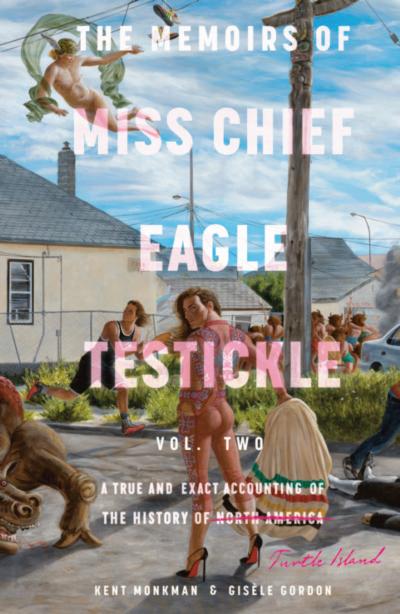
central figure, all drew me in. With tongue in cheek, I opened the book and dove in with an open mind. Once again, with the very first line, on page one, it seemed I was committed. “I slipped off my pink-soled high-heeled moccasins and felt the cool prairie grass beneath my feet slightly wet from dew.” The experiential poetry in that first line tugged me in, I was hooked.
Then again on page one I was impressed by the simple one word description of the white man being rather kindly described as “newcomers” with the description, “with their hairy faces”. This grey-goateed seventyyear-old white man smiled at that apt description.
Kent, what an incredibly wide-ranging illustrative and symbolic portrayal you boldly depict. I commend you. The feeling and emotion so vividly portrayed is stunning. I am impressed. My reactions varied greatly from smiling with joy all the way to frustration that my heritage as a white man

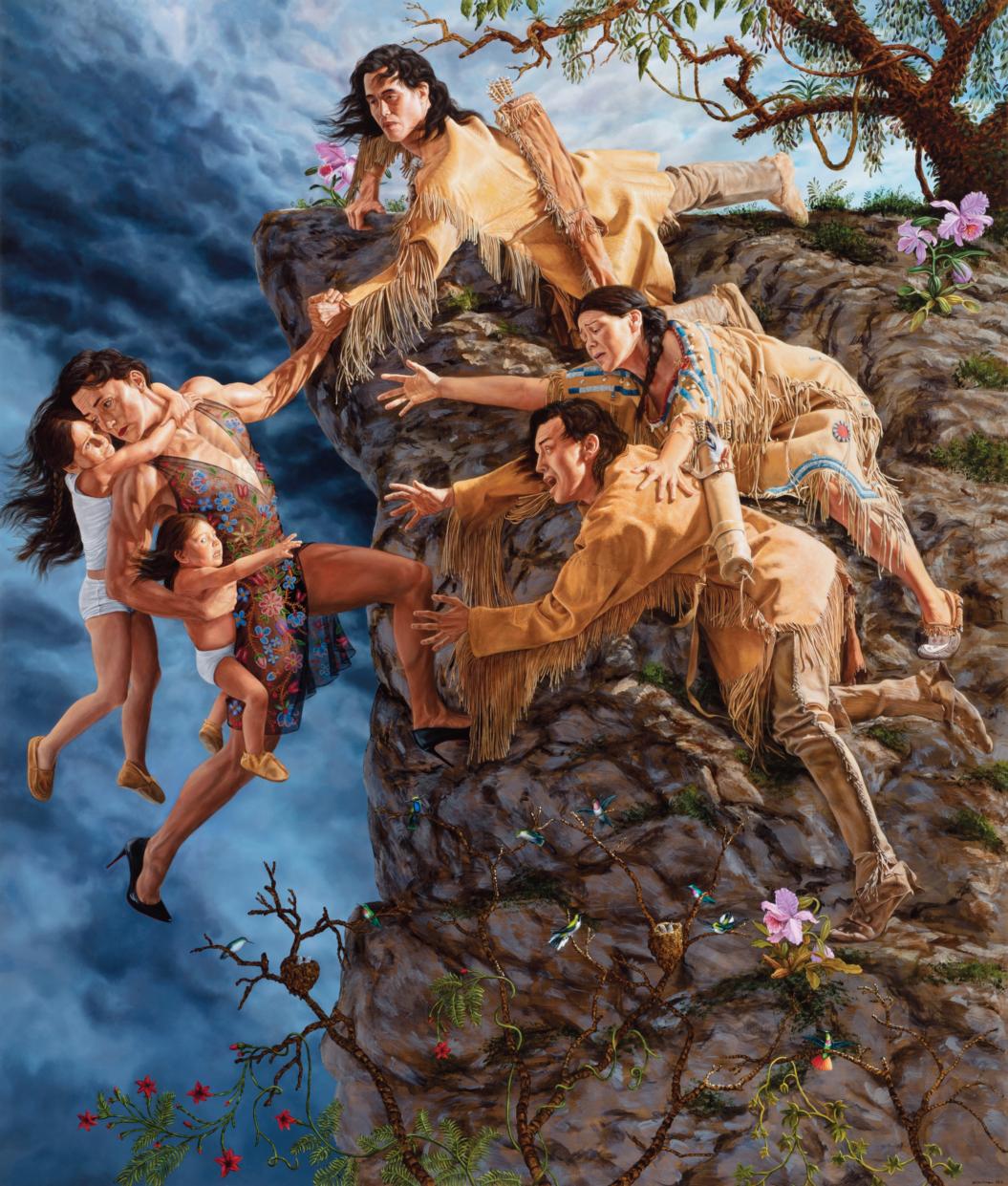

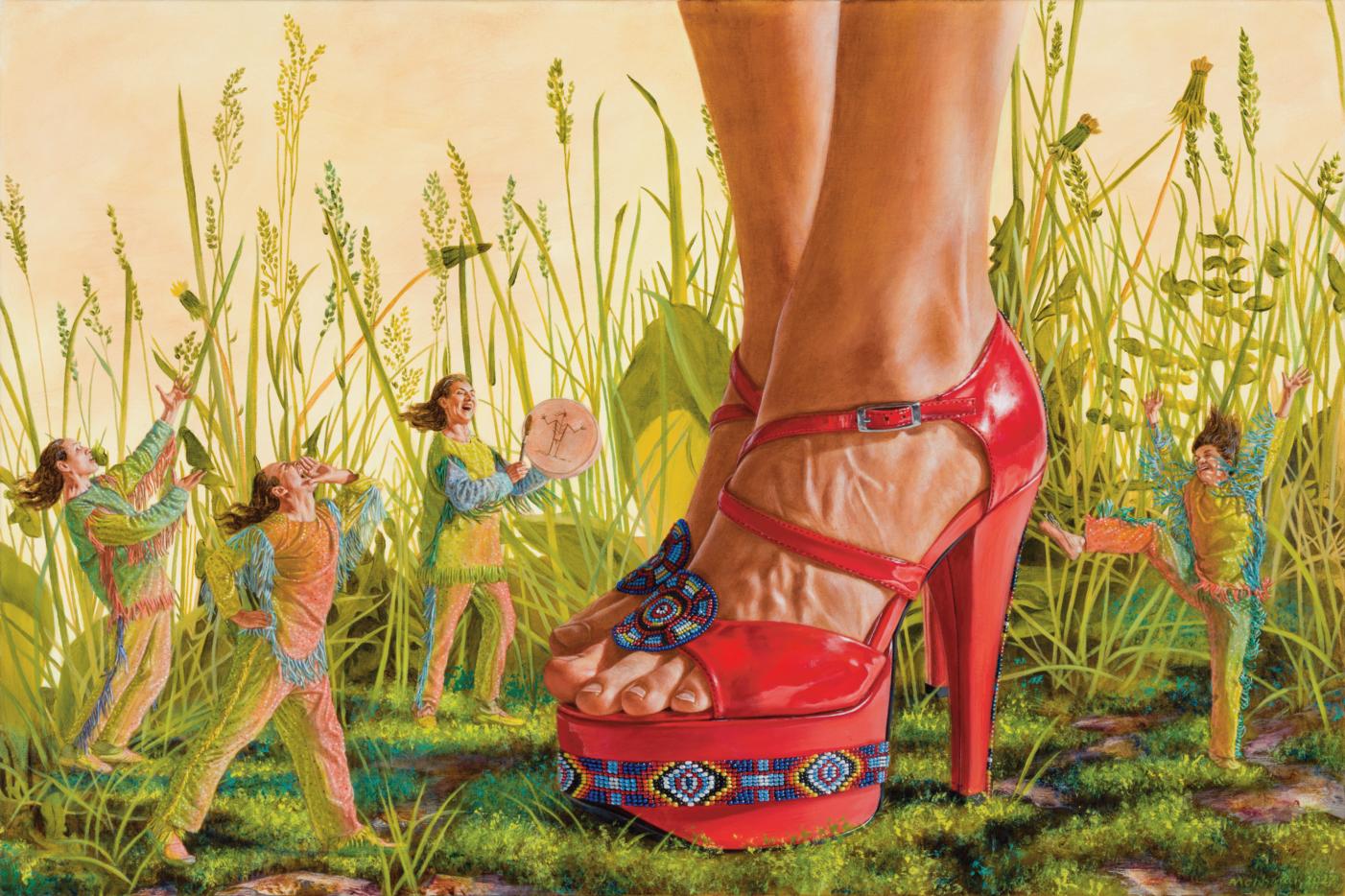
Compositional Study for They Walk Softly on this Earth


Escape
was part of this portrayal of history. Still figuring out the truth that lies between two conflicting versions of history, shame became part of my reading process from the beginning.
In The Memoirs of Miss Chief Eagle Testickle, the titular character, Miss Chief, is a two-spirit, trickster figure who embarks on a journey through time and space. Miss Chief Eagle Testickle’s adventures take her to various historical and contemporary settings, all while challenging stereotypes and confronting the legacies of colonization. Along the way, readers are treated to visually stunning artwork that combines traditional Indigenous art forms with contemporary settler pop culture references.
For decades, the singular and provocative paintings by Cree artist Kent Monkman have featured this recurring character—an alter ego of sorts, a shape-shifting, time-traveling elemental being. Kent Monkman, a celebrated Cree artist known for his works that challenge and reframe historical narratives, collaborates closely with writer and filmmaker Gisèle Gordon.

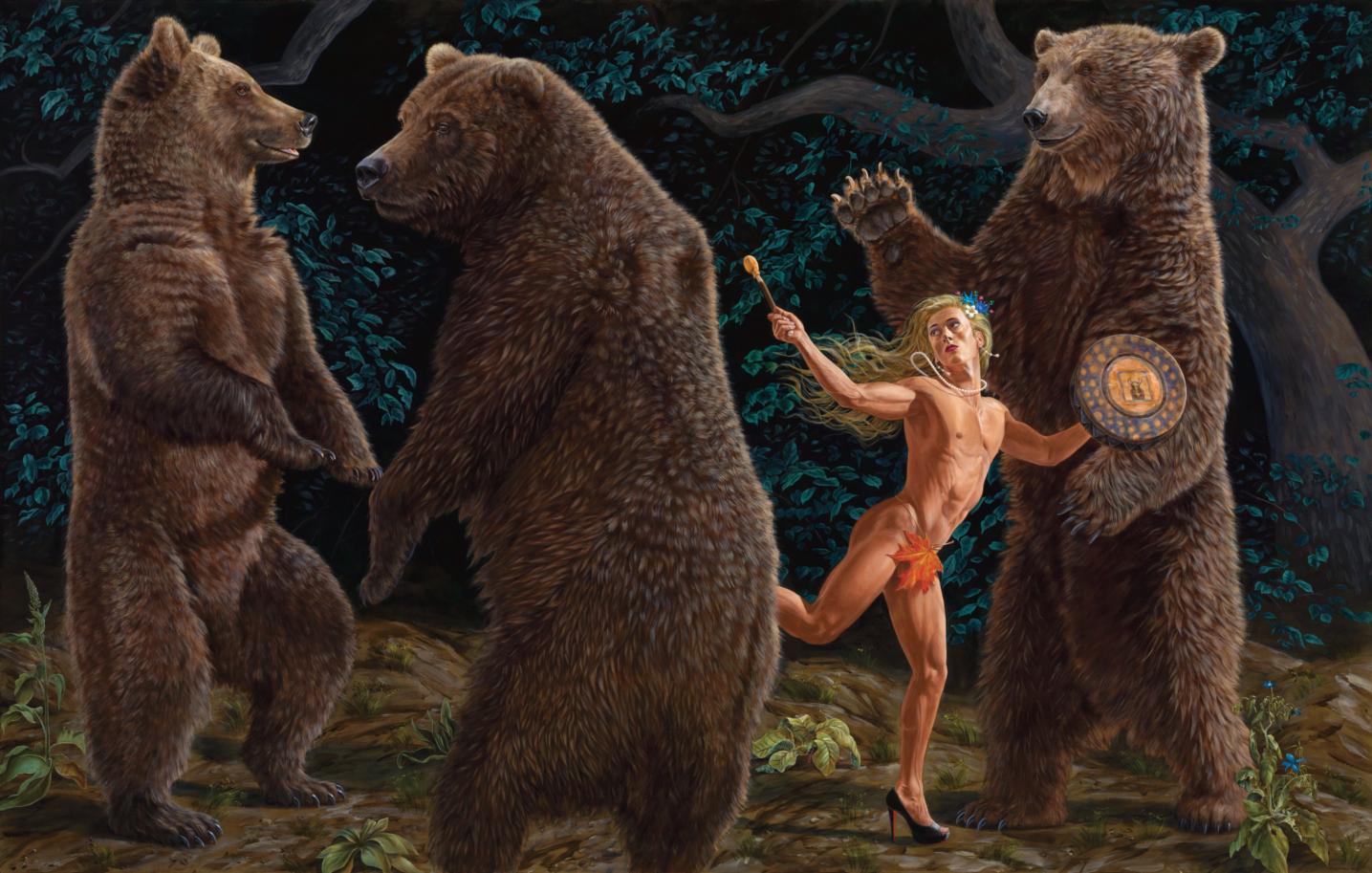
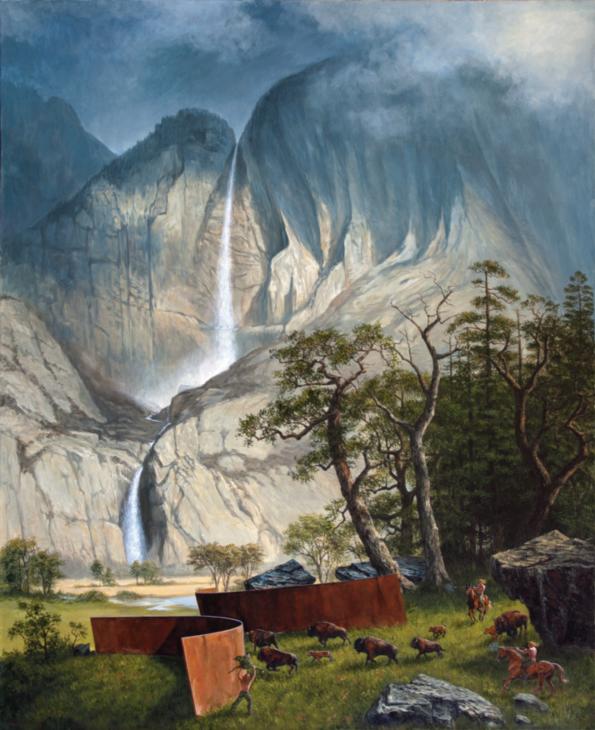

Gordon, an accomplished writer and Monkman’s long-time creative partner, has played a crucial role in shaping the narratives and bringing depth to Monkman’s artistic visions. Their collaboration, spanning over two decades, is rooted in a shared commitment to exploring and presenting Indigenous stories through innovative and impactful storytelling. Together, they have created a body of work that is both provocative and enlightening.
Though the art world has glimpsed Miss Chief Eagle Testickle across the years in films and on countless canvases, it is finally time to hear her story, in her own words and, in doing so, to hear the whole history of Turtle Island anew. The Memoirs of Miss Chief Eagle Testickle: A True and Exact Accounting of the History of Turtle Island is said to be a genre-demolishing work that has been described as “genius”. This fictional memoir, in the form of an imagined history, presents a legendary figure through which profound
truths emerge. This is a deeply Cree and gloriously queer understanding of our shared world, its past, its present, and its possibilities.
Volume One covers the period from the creation of the universe to the confederation of Canada and follows Miss Chief Eagle Testickle as she moves through time, from a complex lived experience of Cree cosmology to the arrival of European settlers, many of whom will be familiar to students of history. An open-hearted being, she tries to live among those settlers and guide them to a deeper understanding of the interconnectedness of all beings and the world itself. As their numbers grow, though, so does conflict, and Miss Chief Eagle Testickle begins to understand that the challenges posed by the hordes of newly arrived Europeans will mean ever greater danger for her, her people, and, by extension, all of the world she cherishes. The cover of this first volume demands attention with a provocatively interesting image with a sexy-legged-long-hair-painted-man wearing stiletto high heels riding behind a blond-haired-muscular-man wearing British-blue military trousers, an image easily recognized in the historic painting, “Napoleon Crossing the Alps” by Jacques-Louis David.
Volume Two takes us from the moment of Confederation to the present day. It is a heartbreaking and intimate examination of the tragedies of the nineteenth and twentieth centuries. Zeroing in on the story of one family told across generations, Miss Chief Eagle Testickle bears witness to the genocidal forces and structures that dispossessed and attempted to erase Indigenous peoples. Featuring many figures pulled from history as well as new individuals created for this story, Volume Two explores the legacy of apparent violence in the children’s residential schools and the urban disconnect of contemporary life. Ultimately, this is a story of resilience and reconnection and charts the beginnings of an Indigenous future that is deeply rooted in an experience of Indigenous history, a perspective that Miss Chief Eagle Testickle, a millennia-old legendary being, can offer like no other.
The cover of this second volume is as provocatively interesting as the cover of volume one. The image is akin to a civilian rebellious uprising with flames, smoke and people running in terror. Miss Chief Eagle Testickle stands naked, sexy long legs reaching to voluptuous buttocks, defiant in the middle of the street, wearing black stiletto high heels. She is a matador holding a Hudson Bay blanket staring down a Picasso-esk deformed buffalo bull that crumbles to the ground.
Blending fiction and history, in a memoiresk styles, is a daring, and should I say, courageous literary step. The Memoirs of Miss Chief Eagle Testickle


is dissimilar to anything published before it. In their attempt to reshape our understanding, Kent Monkman and Gisèle Gordon will change the way we see what lies ahead.
For this essay let’s look at only two of Monkman’s action filled paintings; “The Chase” painted in 2014 and “Miss Chief’s Wet Dream” painted in 2018. In “The Chase” it features a contemporary urban scene interspersed with traditional historical elements, such as stampeding buffalo juxtaposed with an indigenous figure riding a modern red motorcycle. With these two

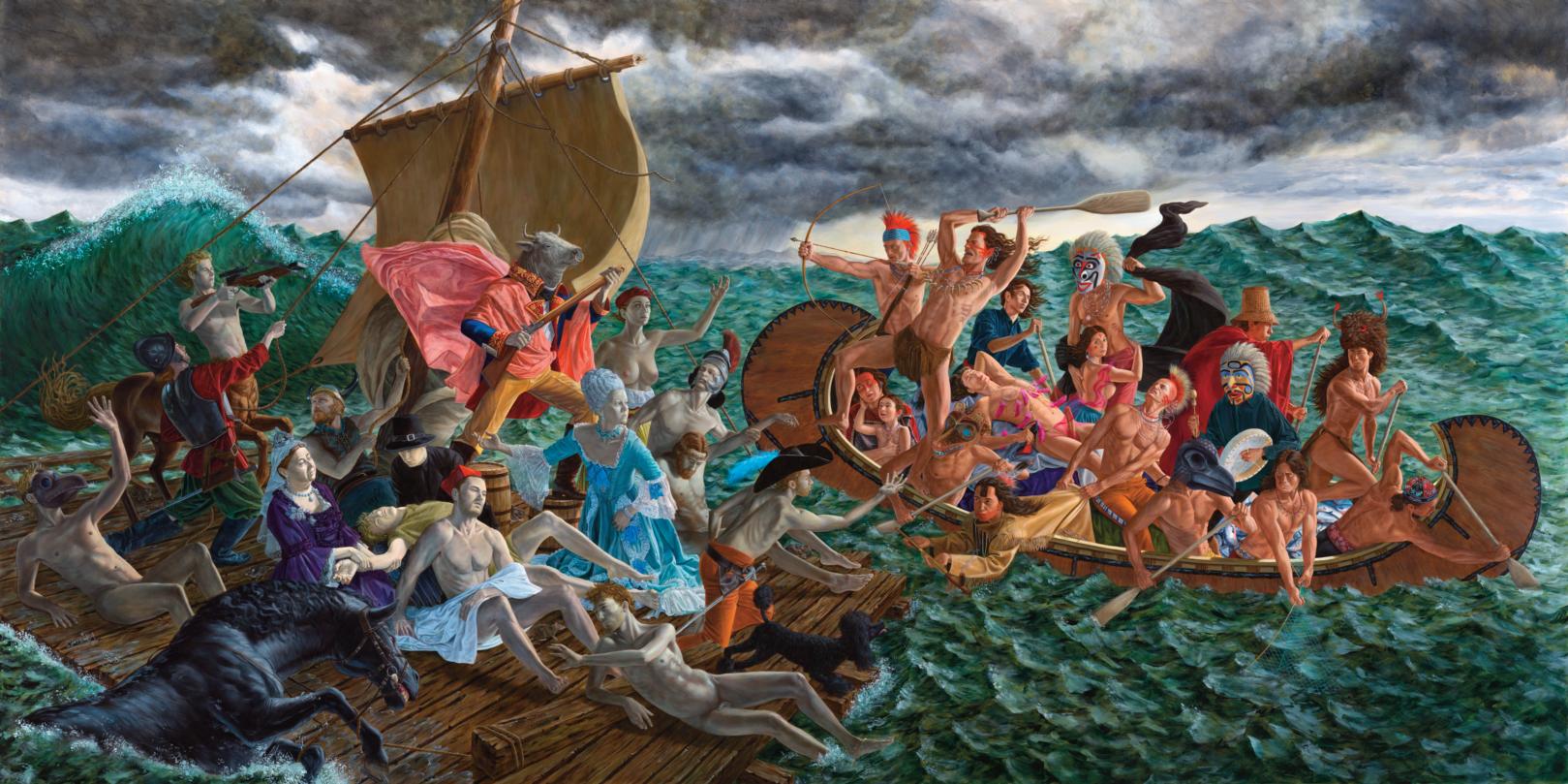
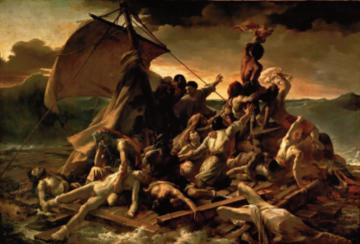

elements Monkman uses his alter ego Miss Chief Eagle Testickle to challenge and critique the narratives surrounding Indigenous history and colonialism.
The other painting “Miss Chief’s Wet Dream” is another vivid and allegorical piece that blends historical references with contemporary social commentary. It features a tumultuous scene on the ocean where Indigenous people in a sturdy canoe appear safe and in control, while European settlers are floundering and drowning on a makeshift raft. This painting is a wonderful direct visual and metaphorical reference to Théodore Géricault’s painting “The Raft of the Medusa” which depicts the aftermath of a contemporary French shipwreck, conveying despair and struggle for


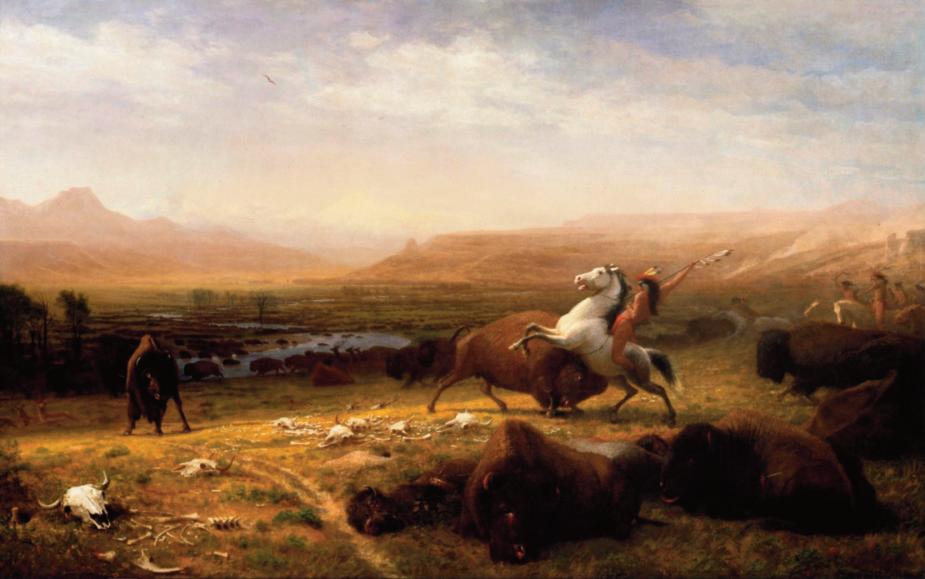

survival. Similarly, Monkman’s painting contrasts the chaos and desperation of the European settlers with the power of the Indigenous people.
Both of these paintings use dramatic imagery that make powerful statements about human suffering and societal issues.
In general, I compare the style and imagery of Monkman’s paintings with the historic paintings of Albert Bierstadt and his famous painting “Witness To A Changing West”. His work can also be compared to several other historical artists, particularly those known for their detailed compositions filled with drama and action. Some notable broad comparisons might include, John Singleton Copley, known for his grand historical and dramatic scenes, often with complex compositions and rich detail such as seen in his painting, “The Death of Major Peirson”. Another comparison might be with Emanuel Leutze, famous for his intense historical painting such as “Washington Crossing the Delaware,” which features a dynamic scene with multiple figures with a strong narrative element. One can hardly ignore this as an influence on Monkman.

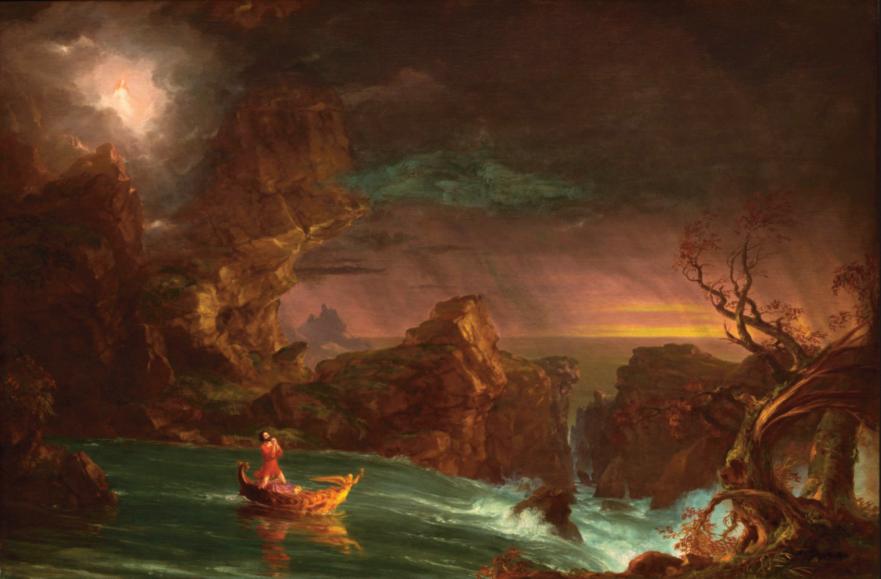
It was amazing how my U of T art history classes flooded back to the surface after seeing Monkman’s images. I had to look into my university notes from years ago to find the painting by Thomas Cole entitled “The Voyage of Life”. This painting with its allegorical drama looks like a painting that Monkman could have painted. I can easily see Miss Chief Eagle Testickle standing in the boat as it heads to treacherous waters.

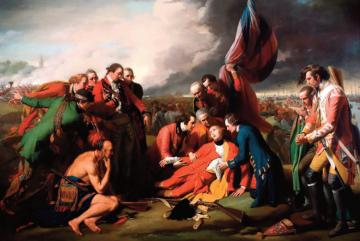


Let me indulge myself with one more comparison by looking at the melodrama found in “The Death of General Wolfe” by Benjamin West. It combined historical accuracy with a dramatic and engaging style the way Monkman is presenting over 200 years later. All of these artists share Monkman’s proclivity for drama, detailed melodramatic figures, narrativerich compositions and cultural relevant themes.
As a proud Canadian I had to look at some of the paintings by Canadian painter, Cornelius David Krieghoff. Even though depicted with less life and death drama some of the paintings by Krieghoff could be construed, at least as an indirect influence on Monkman’s style especially with the painting “Off the Road - The Upset Sleigh” and “Breaking up of a Country Ball”.
See Painting on Back Cover
Monkman firmly claims his narrative and melodramatic style by placing action filled, fanciful, Indigenous experiences at the forefront of his images but I could not help being perplexed by some of the buffalo in his painting “The Chase” as they bear a distinct resemblance to the distorted and abstract forms typical of Pablo Picasso’s Cubist period. I started to think that these buffalo, with their angular and exaggerated features as possibly symbolizing

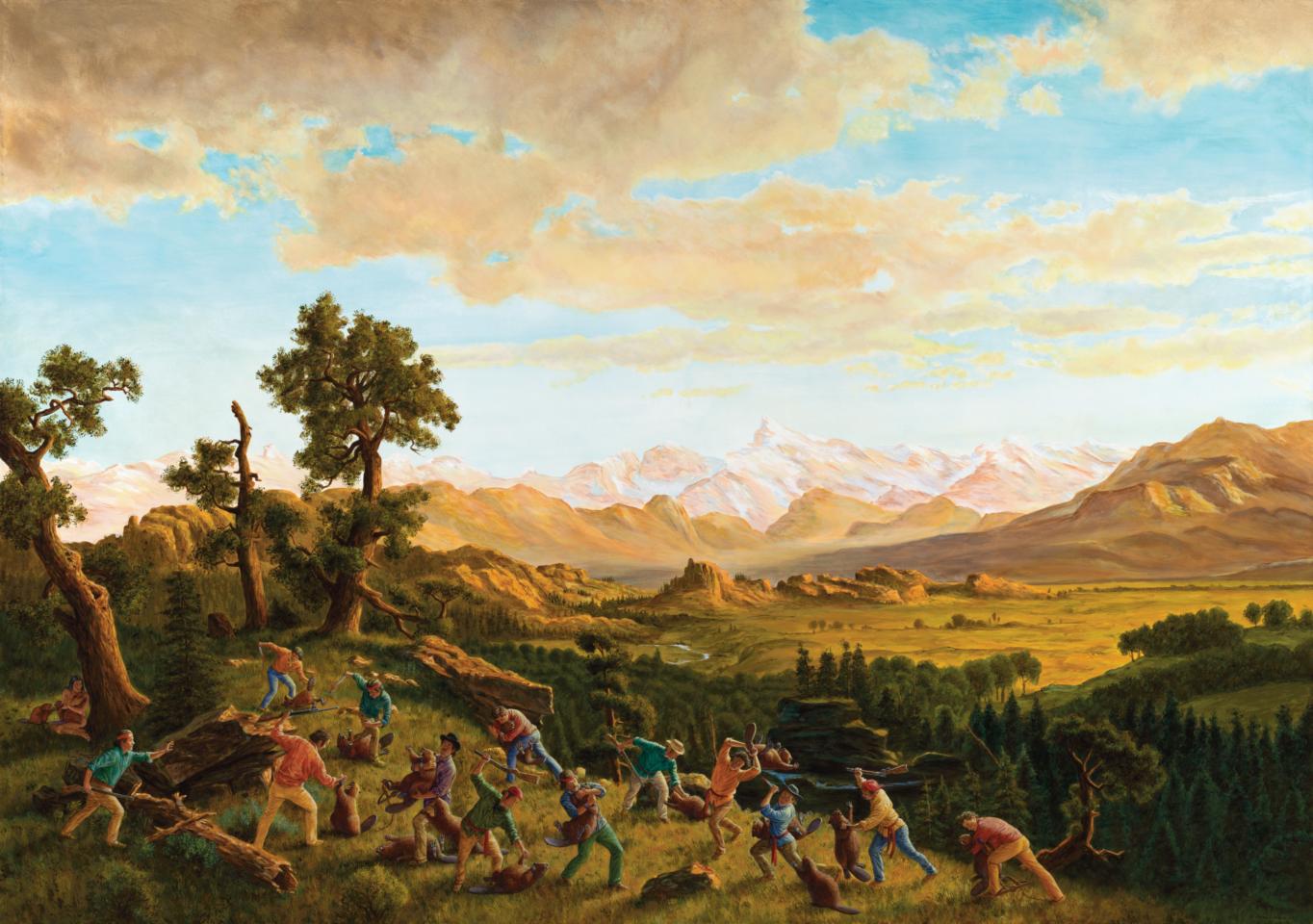
the Indigenous perspective on a fractured and complex history of its people under colonial rule. The melodrama seen in these charging buffalo jumped me to the fragmented forms found in Picasso’s “Guernica,” which depicted the horrors of war.
To put it in a nutshell, this stunning action filled painting, “The Chase”, is a complex and layered work that attempts to bridge historical art forms and contemporary social commentary, using visual elements that enhance its narrative power. The inclusion of modern-day imagery alongside traditional Indigenous symbols creates a powerful statement on the resilience and evolving nature of Indigenous cultures. In a contemporary context all of Monkman’s paintings in this book are aligned with postcolonial art movements that seek to critique and deconstruct historical narratives imposed by colonial powers.
The painting “Miss Chief’s Wet Dream” depicts drowning and struggling white men and represents the turmoil and destructive impact of European colonization on both the Indigenous peoples and the colonizers themselves. It highlights the unsustainable nature of colonial conquest and its detrimental effects. In this painting the Indigenous people are in the sturdy canoe that symbolizes their enduring strength and adaptability. Despite the turbulent waters, they remain composed and in control, underscoring their resilience in the face of adversity. The gesture of an


Indigenous person reaching over to the white man with a peace pipe is a powerful symbol of the desire for peace and reconciliation. It contrasts sharply with the chaos around them, suggesting a willingness to engage in dialogue and healing, even amidst historical conflicts. Miss Chief Eagle Testickle lounges in the middle of the canoe, clutching black stiletto high heels while sporting an impressive erection, adds a layer of provocative satire and commentary on gender, sexuality, and power dynamics. This figure embodies Monkman’s alter ego, challenging traditional gender norms and colonial narratives, while asserting a bold and unapologetic Indigenous identity. To put it simply, this painting is a complex and allegorical narrative, a beautiful melodramatic piece that fits well with the entire collection.
All of the paintings in this collection, from start to finish, will captivate your visual imagination. I hope you enjoy this two volume collection as much as I did.


Gisèle Gordon and Kent Monkman 2023
Poetry Editor: Bruce Kauffman
Photo Editor: Richard M. Grove


Bruce Kauffman lives in Kingston and is a poet, editor, and promoter. His written work has appeared in anthologies and journals, two chapbooks, and five collections of poetry. His latest, still arriving, launched in late spring 2023. He continues to host a monthly open mic reading series called ‘and the journey continues'. He still produces and hosts the weekly radio show called ‘finding a voice’, on CFRC 101.9fm.
uncertain but still coming on the edge of forever a new and next minute arrives
something there's something about brevity that is profoundly beautiful perhaps that's because by its very nature it approaches and attempts to imitate silence
moon
i’d mentioned as i sat down in a crowded room that on my way there that early evening i’d been enthralled watching a sliver of a crescent moon said while sitting there it was my favourite moon you i’m sure helpfully and compassionately reminded me when you said there is really only one moon i said something after that was silly or nonsensical simply to end that tiny thread of conversation that crowded room that night was overly vibrant loud dozens of conversations rolling over the tops of each other competing for space with its even much too loud music on top of that
that small space that evening with too many people too much noise it was not the place to talk about the whispers of the moon or how fragile it is
that evening it neither waxing nor waning but weeping instead








Alanna Veitch alanna.veitch.av@gmail.com
Kingston, Ontario
Writing in the confines of my mind
thisunderground scene words I wish you could read but there is something I fear in you/r knowing yet, one day you will know these somethings you will read my written wishes freeing me from this scene when I will be no longersilent/ced
Allan Briesmaster abriesmaster@outlook.com Thornhill, Ontario
Of the people who carry out their good work (of any kind that’s unharmful in impact) without a thought of it being their “duty,” nor for mere show of outcome or style for the measuring-up to what others exhibit, not for the added inadequate money, nor that they’d be dinged for underperformance; but for the sake of bestowing, attentively, the same fine quality of spent effort they mean to put in to every activity, heedless of credit and reputation, for its intrinsic unsung affirmation of simply, humanly doing one’s best.
Antony Di Nardo dinardoa@mac.com Cobourg, Ontario
Garden Goddess
the lure of the goddess
the bird-paint of cardinal feathers
the rustle & gasp of beauty
the moment she appears
I send for flowers seeds from the sun pine boughsgreen & a privet of leaves for the bower I build with the bend of these words—
the business of writing & calling her back to the nest
April Bulmer april.poet@bell.net Cambridge, Ontario
I take off my muddy boots and hose at Reverend Hart’s portal. I cross his threshold: Barefoot and chilled. He holds me and strokes my wavy hair.
Outside, a new moon: I resolve to care for him and bear us a babe.
His wife passed in the season of ripening fruit. In my dreams, she rests now in an orchard of fallen pears. She is bruised, jaundiced and blue.
There is a god of dying flesh and autumn dew. A god, too, of fertile and pregnant moons.




Carla Hartsfield cjhpoet@gmail.com Saint Catharines, Ontario
was like these roads, rain-soaked, sodden leaves pasted to my windshield, one caught in the wiper blade, a yellow parking ticket—when or how do I pay the fine? My life feels unbound.
Nebulas expand the Milky Way further, wider: glittered fog stretching like waves of water kicked up by tires. Hundreds of us drive to Muskoka before winter’s icy crypt paralyzes
faces, fingers, toes—a natural embalming until we might awaken in Dante’s Paradiso, surrounded by angels and mythic gods. But that is not now. Now is countless kayak and canoe shops, cottage rental signs.
Now is hardly one pit stop along 400 North, 11 North. Gentility rests in the curves of the 117 towards Baysville, a restaurant named The Flat Iron smoking turkeys for Thanksgiving.
I narrowly escape the crush of hungry cottagers crowding its tiny parking lot, few tables— find peace at the Comfy Cozy B&B, a new Paradiso; the stalwart trees show off their lit-from-within reds and golds.
Lanky pines wear pearls of sleet, stand sentinel with wings, no haloes. What if death was one unending flight into a Muskoka weekend? I steady myself on uneven ground, this Empyrean.
Brian Way
btwway@gmail.com
Rednersville, Ontario
second rain is falling harder than the first shards that loved the branches cascading to the earth the parish faithful with umbrellas like turtles to their cars others raise worn bulletins to shield those old old brows bells wail out their singing slippery echoes all around under the dying spire shadows as second rain comes down
Dayle V. E. McBride
dayle.mcbride@sympatico.ca Amherstview, Ontario
Once.
A field left to regain what years of over-planting removed; home to families of wild turkeys, a stopover for migrating Canada Geese, refuge for moles, rabbits, voles and field mice; twenty hectares of wildflowers, ‘heaven’ in the language of butterflies and bees.
Thick forest embraces the field on three sides like a lover; fox and coyote hunt, mate, raise their young. Drawn by a lean winter a snowy owl occupies a veteran fence post, acutely aware of sound and movement.
After five years leafy stalks rise in defiance from stoic ground; a reclamation, a rejuvenation as soil begins its next life. Corn thrives in bounty feed for cattle, seed for birds, a place to hide predator and prey.
From this fallow field a gift in perpetuity.








Denis R. Robillard roepoe72@hotmail.com Windsor, Ontario
I watch his sliver of nothing glide through the air This unsubstantial wafer of wood fluttering Through space and marvel at its efficiency.
Like Alexander Bell up at Bras D’or my imagination Clears the coast and takes off flying to meet it.
And you my son are like an early Wright brother trying to negotiate the nuances of early flight by folding A balsa sandwich into the archaic slip stream And letting it go with all of your might.
And you have grown too my pilot son Like Icarus you have grown some restless wings Some vestigial parts to help escape you Through fields of flume and water And like a drone you will float again over the mouth dry Suckled landscape of your years To make glad again your dull made wings.
Dinh Le Doan dledoan67@gmail.com Beaconsfield, Québec
The clouds glow at dawn. But the sky’s soon glutted with dirty cotton balls.
Leaves and branches droop. Trees stand in a sullen mood. And the docile cedars
of the backyard hedge bow their heads as if all marching dejectedly in a row
toward their impending doom. And yet lucky for them their saviour the sun
comes out in the late afternoon. The hedge and trees breathe sighs of relief.
They bathe in the slanting stream of sunlight. And, like us when we’re overjoyed, they scream aloud in gold green shrieks.
Elaine Yu elaine.yu629@gmail.com
Toronto, Ontario
The ficus tree is a few meters from my desk. I can see it whenever I look up, and it seems still.
Each leaf is like a mini violin, so many hidden melodies hanging there, and only in my sleep, they play together.
When I wake up in the morning, the ground is covered with all the musical notes, and a new movement has come on the branches: They rehearse, and perform, repeatedly, enjoying it, and never getting tired.
Am I frittering away my time?
Or just like them, the delightful changes always happens, but only inside. The appearance seems still.
Eva Kolacz eva.kolacz@gmail.com Victoria, British Columbia
ungrateful?
How charming you are, life (I’m tempted)your words are well-versed and designed with a careful selection of flavours:
“It’s not so bad just to gather the remains, maybe something will come out of it”
when I carelessly put my hand out, a vicious circle takes my whole body now I’m spinning, spinning
love is a sketch, a few lines easily washed away by droplets of water
I see the night leaving slowly, the dawn climbing on the windowsill,
feeling a faint taste of hunger I stand before the mirror preparing for people a joyful face with the help of lipstick from Dior and in return to live up to your reputation, I will splash your face with laughter
George Elliott Clarke torontopoetlaureate@gmail.com
Toronto, Ontario
Amsterdamned Torontonians
(pace Amatoritsero Ede)
Wherever we exiles vamoose, we betray borders. Our eminent terminus? A tombstone.
A shipwreck in thin air: A lover floundering in silk, bailing out perfume.
The tarnished sun dangles like a crepe-paper sunflower.
All our paramours weigh-in— either Botero-chubby or Giacometti-skinny!
As schizophrenic as an epic penned as lyric, penile Terror shrinks from uterine Pleasure.
Amsterdam is sea-smoke ripasso ferrying hints of leather, dates, black licorice.
Toronto is obstinately bourgeois: Sunset gilding banks, secretaries burning bras.
But there’s meat to eat, furs for body heat, bones for knives, blood for ink.
Honest loves haunt the ravines and riverbanks, scoop up salmon, gut muskrats.
Never comes the nutritionist to the feast; nor the bigot to the orgy.
Keith Inman inman@vaxxine.com Thorold, Ontario
in a flowered tracksuit she stands below a flashing Walk sign then looks up from her cell phone and begins to drag her rolling thunder luggage across six lanes of traffic as a city bus awaits her attention — her screen mapping her way as an SUV swerves across the yellow and powers its way through thoughts of spring

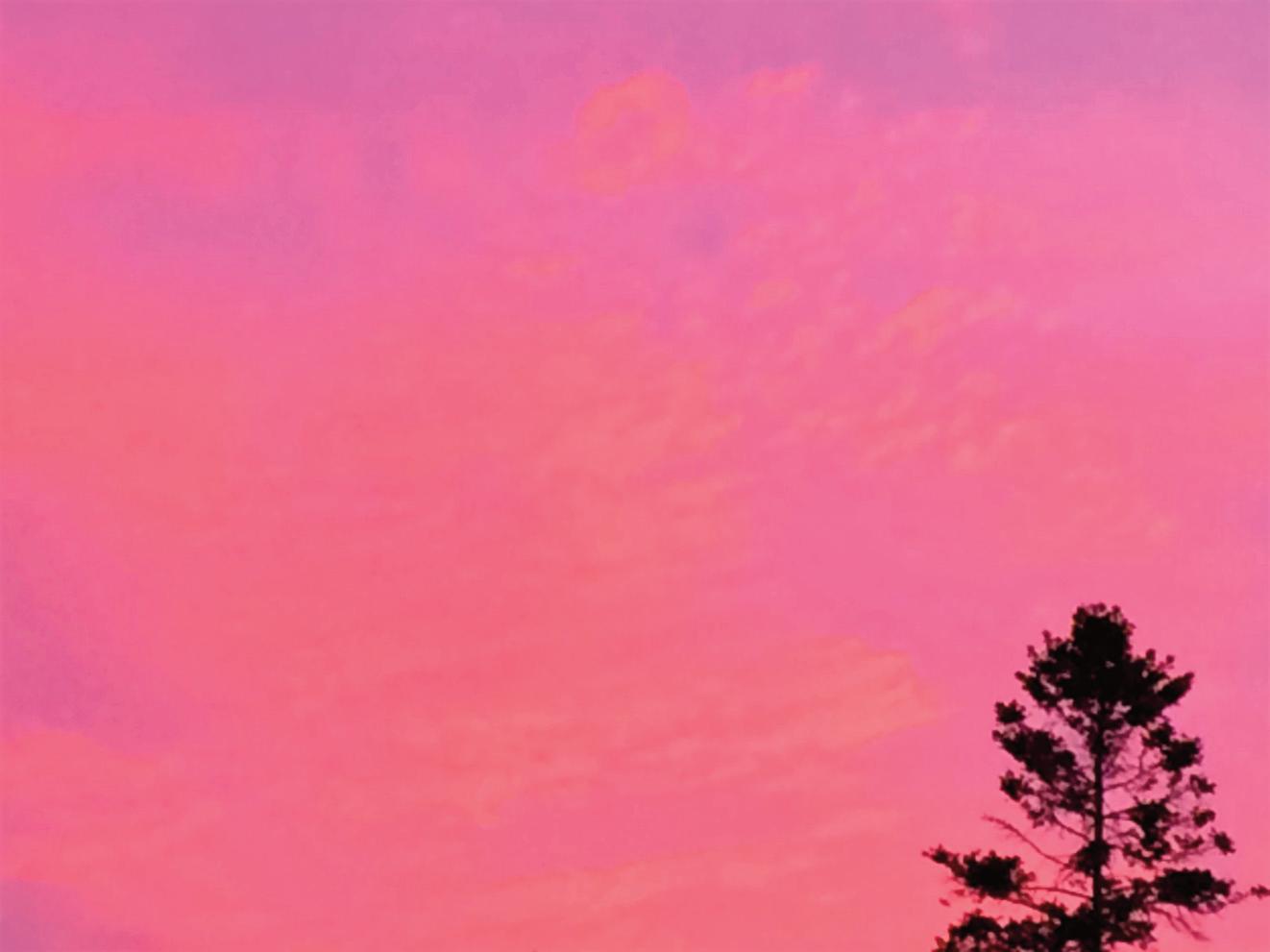






John B. Lee johnbleejbl@gmail.com
Port
Dover, Ontario
today I am blessed by the briefest memory of Mother slow walking the short rows of her garden in a week of dry weather as she with her bucket and dipper is soothing the earth where it darkens with dampness like the napping of suede where in the care-filled washaway she’s exposing the fine hairs of the most delicate roots like the threads of plucked mending what a seamstress might call the frogging of errors and oh, she is come as a gentle rain comes with her liquid elixir pouring it out on the sweetening soil with the languor of loving as you would were you washing the hair of a child that warm overspill slaking the green thirst that’s lifting the leaf as with an awakening out of the dust of photosynthetic dreamers accepting the alms of the well so deep in the world
it seems a revival of rivers seeping through limestone and subterranean slate a secular and sacred devoir – oh Mother you are but an eidolon of morning like mist in mysterious light the way something we do or have done long ago clarifies over time into vanishing blue like the fading away of a breath in a vale
Glen Sorestad sorstd@sasktel.net
Saskatoon, Saskatchewan
I just want to be left to myself, to revel in the peace and bliss of silence, no telephone callers with their insistent demands, and their scams, or the legions of organizational beggars, licensed and trained to ignore the simple answer, No. I just want to have a quiet home, where I can read or write a poem, or accomplish anything I want, free from the world’s interrupters.
Then, there are days when I do not want to interact with anyone, least of all, strangers, wanting replies to questions I cannot answer, or even understand. I must appear to strangers as a father confessor. They always find me.
Many days, I just lack interest in leaving the house to go anywhere. So, I don’t. But sooner or later, usually sooner, the outside world always wins and lures me out, mostly unwillingly, sometimes unwittingly. But some days, when I recognize in a stranger a kindred soul that needs a morale infusion, I come home giddy with satisfaction, thinking: I really need to get out more.
K.V. Skene kv.skene@gmail.com
Toronto, Ontario
Some days I can be as mysterious as the moon
although I often suffer a disconnection between whatever I’m told is possible my beating heart believes in a world that is always forever even as day-to-day begets those endless longings and griefs the song beneath the song that everyone I once knew heard and felt and followed and believed
although I still fear the thoughts that tumble straight through my head-in-the-clouds brain as mountains move rearrange the winds that rule all changes transcend the harm beneath the charms that lie in-between us and the singing moon like a child
someday I know someone perhaps someone like you will ask me to reach out my cool dry hand and pull them up
because I always know the way home
Katerina Vaughan Fretwell kfretwell@cogeco.ca
St. Catharines, Ontario
Zeroing in on 80, I lift kettle-balls, squat on band-tightened thighs, stretch shoulder blades into kissing cousins, swim half a mile in thirty, pedal over half a K in five.
Only a few of us snowy heads pace alongside marble-muscled jocks raising the bar.
Each added weight, stroke or rep steps me beyond high risk hip fractures. My trainer and I rap beliefs during reps. Only one week breathes between Jess’s 30th and my 80th markers, half a century apart but aligned.
Yeah, I’m high on healing for health, fortunately affording fitness and guide.
On Thanksgiving ‘22 at the Balls Falls Fair, I gasped up a mini hill, driving my daughter to hustle me to the gym and Jess.
Bit by bit, body fat melts, muscle mass solidifies. Numbers dance in my blood, heart, soul.
Richard M. (Tai) Grove richardgrovetai@gmail.com Toronto, Ontario
Presqu’ile Provincial Park,
In this tender tapestry of spring’s embrace, evening light whispers her setting serenity. Light spills gently across endless skies, where hues of succulent peach and the comfort of lavender melt into hazing horizon.
Draped below the hush of fading light lays the expanse of verdant marsh with tattered bulrushes, new shoots, stretching towards warming sun’s embrace.
The air is a delicious blend of cool breeze and earthy freshness, carrying the subtle scent of spring’s promise. Silhouetted against soft glow, tall grasses sway gently, tips caressed by mourning-light of lamentation.
In this moment, nature sings a quiet hymn of peace and rejuvenation, a sanctuary of budding beauty at day’s tugging twilight.

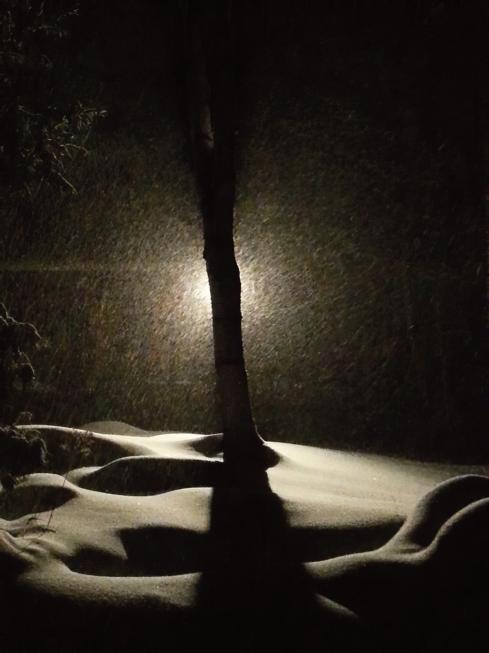


Robert Currie currie.robertdm@gmail.com Moose Jaw, Saskatchewan
There’s a special way you move, a lovely flash of limbs that drives away depression like hallelujah hymns.
Beyond the earth it lifts me. My eyes, like starships, shine. Of an inner difference they are the outer sign.
There’s moonlight in your movement, heaven in your hair, an ethereal temptation that prompts an earthly prayer.
When you come near, shadows shudder, sunshine breathes a sigh. When you’re here, you make me feel like royalty in Versailles.
Susan Smith essaysmith69@gmail.com
St. Catharines, Ontario
Leaf-buds are aching to open.
Where is the reply to that message I sent in the middle of the night?
The day waits, desolate or enchanting.
Teresa Hall thallartist@gmail.com
Scarborough,
Ontario
Like a promise I will return this spring following contours of the Earth. Magnetic fields will tell me everything, latitudes I’ll need to know traversing nine thousand miles before I reach the golden plain where I began.
My soul the very part of cosmic winds where jet streams ebb and flow, hastening me on.
Long flight past desert beds –green marshy wetlands beckoning. Rest here till journey’s upward lift will carry me beyond, yet still five thousand endless miles to go.
The only sound the steady beating of my wings.
One final push through storm filled cloudsreconfiguring.
Familiar swirling waters call below my feet touch glistening sands, I’m home.
Theodore Michael Christou theodore.christou@queensu.ca Kingston, Ontario
i find a symphony of self, a harmony of contradictions— the splendor of solitude, the cacophony of connection, all held within the heart of the sea, the soul of me.
wind and water weave my world, a tapestry of tumult and tranquility, where the wild heart beats beneath a serene surface, and silence speaks louder than the storm.
i am the sea, solitary yet sprawling, a world within, where depths hold dreams, and the surface reflects the semblance of the sky, the lonely sea, the solitary self, ever changing, eternally encompassing, a universe unto myself.
A. F. Moritz albert.moritz@utoronto.ca
Toronto, Ontario
You told me you were on a path— a path you called it—and frantic to take all other paths. Frantic to have taken all others you’d ever noticed. As you went, you crossed intersections, bypassed side roads and heads of trails, maybe human, maybe animal, maybe nothing at all, just vegetable gaps. How anxious you were not to be accused of having not seen everything that is essential. You trembled with torturing eagerness at the maw of every turn-off. But if you ever took one, you said it was the same. It was the path you were on and it went along bypassing many others, filling your memory with roads to who knows what—nightmares, lands of dream. Every way you went, it was the path, and around it: the clustering of shadows, something like dense woods beginning to stir in a night wind, memories of alley-mouths, openings half-barred by branches and leaves…

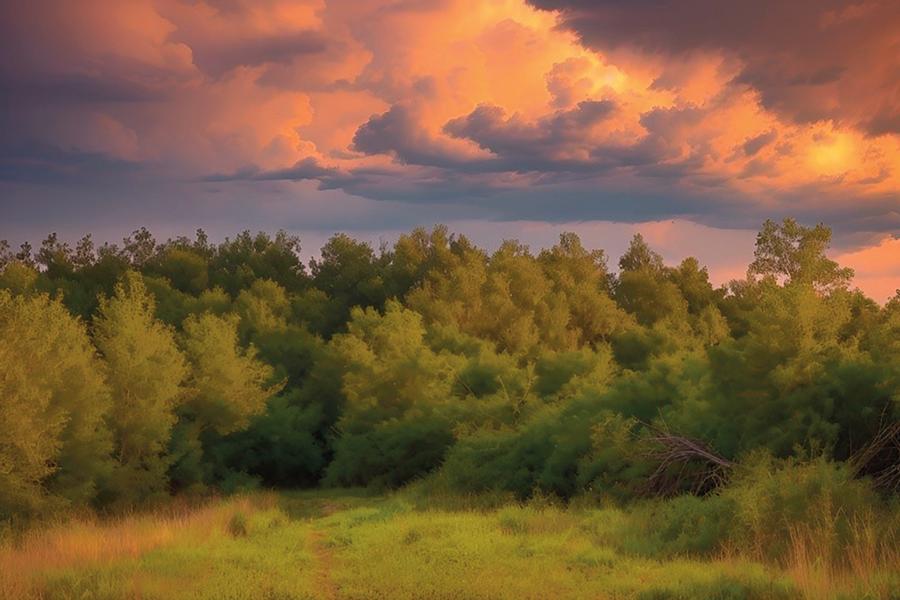







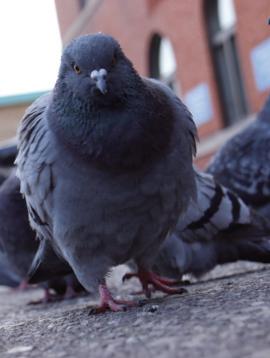




An Essay on Allan Briesmaster’s book of poetry Windfor.
Review
Essay by Richard M. Grove
Publisher, Writer, Poet, Reviewer, Editor,
Photographer.
Allan Briesmaster stands as one of Canada’s finest poets, a reputation well-earned through his now nine full books and nine chapbooks, all fine contributions to the CanLit landscape. His latest book, Windfor, published by Ekstasis Editions in 2021, encapsulates his profound engagement with both the metaphysical and the personal realms. This collection of poetry exemplifies Briesmaster’s masterful use of language and his deep philosophical insights, offering readers a rich human experience.
The book opens with this profound and moving poem: esse est percipi*
In the end, after all, nobody goes with me. But through the whole middle, in-between solitudes, I have no real life without you. Am nothing, now, unless you notice me. No value, unless you confer it. Otherwise: doubt, toward despair. If I can make you smile, if I can offer you gifts, and help, thought and praise – only then will I dwell on earth. Be my self here. Become somebody. How else can existence acquire substance, except as bright horizons of our meaning meet?
*(To be is to be perceived.)
As you can see, it, in part, reads as a love poem to his dear artistwife, Holly, but the reader is invited to understand existence beyond that singular relationship into a metaphysical relationship with all that we connect with.
The thematic essence of Windfor revolves around restlessness and the search for connections—both human and cosmic. If this is not too much of a mouthful, I should say that Briesmaster’s book is like a meditation on existence, identity, and the quest for meaning in an often tumultuous world. These poems explore the yearning for human connections, the ponderings of self-identity, and the search for equilibrium within the cosmos.
The structure of Windfor is meticulously crafted, with each poem contributing to a cohesive exploration of the book’s central themes. The opening section, “A Traveller”, introduces the reader to Briesmaster’s contemplative journey into life, blending autobiographical elements with broader existential reflections. Poems like “esse est percipi” as already mentioned and “Going Elsewhere” delve into the poet’s introspective quest for identity and connection to the larger world. These two poems set the tone for the reflective nature of the collection as a whole. Let’s look at “Going Elsewhere” right now.
One of my mother’s earliest anecdotes (cringe-worthy to a grown son when repeated) has her doing laundry and then not finding me in rooms or yard. In the neighbour’s pasture, there stood the diapered toddler, entranced among the cows, almost under their hooves. After we moved up to Great Aunt Bessie’s Victorian-gothic hilltop nursing home came further running away. T hree-year-old legs propelled me across the broad swath of lawn to pine-needled paths through the woods. I was found seated happily on a log in the deep shade.
So then, what, if anything, was that child after? It must essentially be what still draws me and awaits “out there” beyond nature’s charms or the lure of adventure. Not sheer escape from close confinement or boredom, either, but a fresh outlet toward an unhindered view.
In the swift Anthropocene (a too-porous dwelling-space thru-scanned and looped algorithmically, all enclaves co-opted by global enterprise, private and historic memory digitized) one seeks a means, other than turning self-harmful, of unmooring from surveilled GPS. Making no permanent home anywhere earthly, when broken off into zones of tall solitude I shed my ill-fitted coat of identity. As with high art heard and musical depth visioned, an emptying-out of dubious emptiness bodes how one once came from, then returns, someplace else.
As you see, this poem is well rooted autobiographically, as Briesmaster portrays himself as a diapered toddler among the cows, almost under their hooves, but he carries the reader into a deeper meaning as he sheds his “ill-fitted coat” of identity.
This second poem in the first section “Going Elsewhere” serves as a perfect continuation of the themes introduced in the preceding poem, “esse est percipi.” “Going Elsewhere” delves into the inherent human desire for exploration and the quest for a deeper, more meaningful existence highlighting an early and intrinsic urge to seek beyond the immediate and familiar. This poem is not just a fun anecdote. It becomes a metaphor for the poet’s lifelong pursuit of new experiences. Even at the burgeoning age of three he was calmly looking for new perspectives, suggesting that this yearning is not merely about movement through time but a deeper spiritual and intellectual quest. I have known Allan as a colleague and fellow poet
for decades, but this poem, more than others, has told me a lot about his questing nature. The toddler’s ventures into the neighbour’s pasture and the woods symbolize his fundamental human drive to transcend boundaries and discover uncharted territories of the self and the world. For me “Going Elsewhere” is an introspective piece that with thoughtful reflection will encourage readers to embrace the journey of self-discovery even if it takes one close to being trampled by hooves.
The second section, “From Division”, delves deeper into interpersonal relationships and internal psychology. Here, Briesmaster’s abstract treatment of these subjects allows for a nuanced exploration of the human condition. Poems such as the eponymous titled poem “Windfor” reflect on the inherent contradictions of existence, capturing the perpetual tension between the desire for stability and the inevitability of change. Here is the entire poem.
Windfor
Give me wind for my eyes. They are so scaled –not like fish but pipes perhaps, or else too often calibrating, hung unaligned, with weight of one pan dipping down, bent away from the other. A constellation of two is salvation along the slide of the temporary. Another like, also unlike, myself to round my orbit and fill these eyes with clear concern overturning the screen of disinterest from common reaches across common ground. Let me open the lonely windows. Let air, backed by the sun of your look, circle in.
Give us wind for our eyes.
At the risk of rattling on a bit too much about this poem, I will hold you here for a moment and suggest that its thesis is the desire to feel and see more clearly. It captures the yearning for clarity and connection. Even though this is not a sentimental or narrative poem and it demanded a few reads, its appeal lies in the intricate interplay of imagery and emotion, as the poet navigates through themes of perception, imbalance, and the quest for understanding.
The opening lines, “Give me wind for my eyes. / They are so scaled”, immediately immerse the reader in a metaphorical landscape. The author, with no equivocation, tells us bluntly that the poet’s eyes are “scaled, not like fish but pipes perhaps”. Have you ever seen scale in a pipe? What a great metaphor. It is the encrusted accumulation that takes years to build up and is difficult to clear without great effort. This unusual comparison effectively conveys a sense of obstruction and detachment, setting the stage for the central theme of the poem: the desire to see and feel more clearly.
As the poem progresses, the poet delves deeper into the idea of imbalance with the lines “or else too often calibrating, / hung unaligned, with weight of one / pan dipping down, / bent away from the other.” This vivid depiction of a skewed scale illustrates a personal dissonance, a life out of balance. The imagery is both powerful and relatable, as it speaks to the universal human experience of feeling offkilter, searching for equilibrium.
The closing lines, “Let me open the lonely windows. / Let air, backed by the sun of your look, / circle in. / Give us wind for our eyes”, might be thought of as both a plea and a resolution. The metaphor of opening windows to let in clarity; fresh air and sunlight signifies a willingness to embrace vulnerability and openness. The repetition of the request for “wind for our eyes” reinforces the central theme of the entire book of seeking clarity and connection. The poet’s skillful use of metaphor and evocative language makes this a memorable and moving piece.
The third and final section of the book, ‘On All These Walks”, brings the reader back to the natural world, grounding the metaphysical explorations in tangible experiences. Briesmaster’s vivid descriptions of nature-walks and his reflections on seasonal changes
serve as a reminder of the interconnectedness of all life. The poem “Pod” is a particularly striking example, where the poet draws parallels between the life cycle of a pod and his own existential musings. Here is the full poem for you to ponder.
Pod
Soft warty surface, darkgreen. Cylindrical, pointy-ended, its nose a little pale cone on an eyeless face. At stem-end: a black mouse-like tail. Smells green, too. Slightly moist. And inside, I sense a fibrous padding encasing the seeds. I too am pod. Below a thin layer, seal in and cushion gestating pips from arid light-of-day until a split-apart rind ejects them on proper soil. Or is it more valid just to envisage a fallen brown shape crack open to insects’ ministrations –or else a famished animal gulp it and later drop what’s indigestible on unimaginably far ground?
How is that for a contemplative and richly textured poem as the opening for the final section? Briesmaster skillfully intertwines natural imagery with human themes, making such resonant connections between the botanical and the existential, making the poem a compelling and thought-provoking read by drawing parallels between plant life and human existence. The poem begins with a rich, sensory description of some sort of a pod, drawing readers into its textured material world. The “soft warty surface” and “darkgreen” color immediately establish a tactile and visual connection, while the
cylindrical shape and “pointy-ended” nose give the pod an almost animalistic quality, emphasized by the “black mouse-like tail” at the stem-end. This anthropomorphic portrayal makes the pod feel both familiar and alien, bridging the gap between plant and animal life.
Briesmaster masterfully shifts from the external description of the pod to an introspective reflection, drawing a parallel between the pod and the human condition. The line “I too am pod” serves as an axis, transforming the poem from a mere observation of nature to a contemplation of self. The thin layer that “seals in and cushions gestating pips” becomes a metaphor for the human experience of nurturing and protecting one’s inner potential from the harshness of the outside world. This metaphor is beautifully extended with the image of the pod splitting apart to release its seeds into “proper soil”, symbolizing the eventual release and realization of one’s potential in a conducive environment.
The poem then contemplates different scenarios of dispersal and regeneration. These possibilities reflect the unpredictable nature of life’s journey and the various ways in which one’s influence and legacy can be spread.
Briesmaster’s well-crafted language invites the reader to ponder the delicate balance of protection and vulnerability, potential and realization. The poem’s structure, with its seamless transition from external observation to internal reflection, mirrors the theme of the entire book.
Thank you, Allan, for this thoughtful and compelling book. It left me with a contemplative smile.




Prof. Miguel Ángel Olivé Iglesias. BEd, MSc
Cuban President of the Canada Cuba Literary Alliance
General VP of the Canada Caribbean Literary Alliance Author, Poet, Writer, Editor, Lit Reviewer, Translator
With Master’s degrees in religious studies and theological studies, as well as creative writing, April Bulmer revisits us bringing her spiritual storylands along in Good Grief, a 2023 publication. But first let’s read observations about her previous work. John B. Lee, in his Intro words to samples of her poetry in Beyond the Seventh Morning (SandCrab Books, 2013), tells us: “When we pray, when we create, when we love and are loved… the soul in us shines, and we feel the covenant with God, the universe and all.”
The collection of Bulmer poems I comment on today takes spirituality and religiousness again to territories she ably shapes and colours. According to John B. Lee, in his words introducing another of Bulmer’s books, Out of Darkness, Light (Hidden Brook Press, 2018 - a John B. Lee Signature Series book), with her poems we enter the world of her “lovely metaphysical poetry where the metaphysics are simplified by the clarity of luminous lines.”
Obviously, Bulmer pours all of herself onto the pages in a revelation of a quasi-corporeal world she lives in and experiences as her own. The poet engages us with the originality of her style. Good Grief impresses for the distinct, profound elaboration on the theme she has chosen, a signature of her penmanship for years. I count fifty-six independent pieces that can be viewed as a single poetic column telling a story, as I state later, that is the chronicle of a woman’s life.
The title, a phrase we generally see and use with an exclamation mark,
foretells what is to come. However, the absence, probably intentional (my opinion), of the exclamatory sign, might convey a variety of connotations. One of them is that the poet, focused on the Hart figure, now looks at what she is recounting from a more mature, observant, acute perspective. We perceive a necessary attempt at more calmly taking in and therefrom depicting a reality Bulmer lays out for the reader.
The Bible tells us: “… for by the sadness of the countenance the heart is made better.” (Ecclesiastes 7:3). So, another thought about the title is that in breaking, purposely, the oxymoronic essence of the phrase, we approach it as two separate words, good and grief. Thus we may discern more insightfully what Ecclesiastes 7:3 purports. In grief we grow, we learn, we brace ourselves for challenges ahead. There lies a less gloomy side of grieving. We cannot escape the blows of life, so we must prepare to face them and rise above tragedy.
It is a fact that a review won’t cover the entirety of a book’s content. Consequently, I will select some poems and/or fragments to substantiate my notes, which will be hopefully enough for the reader’s interpretation of Bulmer’s resourceful competence as a poet who is sending an outstanding message, and of her stature as a woman of palpable sensibility and intense worldview.
Her character in the book, Theodora Hart, in Bulmer’s words, “… speaks in many tongues: In the languages of lean land and of love.” This is what we feel as we read and suffer, read and experience—read and relate to. Being both Bulmer and Hart spiritual women, we are absorbed and enlightened, caught and transported by the poet’s mystical narrative.
Her first poem [the poems have no title, so I will identify each I refer to by quoting the first line], “In the moons of her youth,” we walk right into a compound of biblical allusions and images,
… my mother’s womb is red and firm as the apple though it sheds like the serpent…
… Eve’s issue flows between her hips. Our eyes quickly catch apple, serpent, Eve as signposts of a biblical foundation Bulmer sets for her poem, a foundation that supports her whole poetic structure. Let’s keep in mind that it is Theodora speaking, so we are fully introduced, since poem one, to a storyline that promises to be a passage of confession, endurance and sacrifice:
But woman’s wound does not cease its ache and blood.
The stanza
She kneels among a sacrifice of flowers and lifts a bloom: A chalice to her lips
carries an extra richness of significance and figurative language. The poet speaks of sacrifice in a woman, having to conceive and give birth, yet a bloom is lifted, and it is a chalice. The word chalice, in context (flowers), applies to the cup-shaped interior of a flower, but there is no doubt as to the extended implication: the cup used in the sacrament of the Lord’s Supper. Hence the religious import of the lines Bulmer weaves.
The second poem, “Soft earth opens…,” continues the plot knit by Bulmer, in what we may feel as a poetic chronicle or biography. Here, the poet defines her birth and coming into the world as emerging from a wound. We cannot help but imagine that moment of surrendering, pain, cries and, ultimately, joy. This is how the poet presents it:
Bulbs crown from her thighs and bloom.
Fish swim from the river’s hips…
… I am born of a wound.
“I am born on…,” poem three, illuminates the reader as to where reason and spirit, sacrifice, fortitude and credence come to a meeting point. The St. Monica reference leads us to the old Algerian history, A. D., of the Christian woman who outstands today in the Catholic world as a model wife and Christian, a woman of great kindness and piety, a devoted mother who cared for the family even in the most adverse circumstances.
St. Monica suffered greatly but her faith and patience rendered fruit we admire. Let’s notice that the St. Monica celebration is a feast today, a commemoration of resolution and survival.
There are latent convergences between Hart and Monica, which Bulmer skillfully interconnects in the poem. The character’s unwavering religious conviction is in it, the last line reflecting her conception of stoicism and hope
going together, that is, she weeps—aching inside—but she hopes—an entreaty to God:
I am born on the Feast of St. Monica, the sun at high noon.
I dream young of Saviour’s slender arms.
I weep a prayer.
“Morning with the Son,” poem four, touches the heart and ignites genuine emotions. Bulmer sculpts those lines rather than writes them. It is an experiential instant where senses (sight and touch), are united so the moment’s magnitude is truly, directly felt. That particular morning becomes a unique one. The fact that Bulmer adds that there is light streaming in, heightens the already elevated sensations arising from the context—because the light is the Son, and the Son is light.
The simile like candlewax is accurately evocative, and the closing words, I trace them with my glove, awe-inspiring. Bulmer’s creativity reaches a responsive, highly-moving cusp where seeing the Son is complemented with touching Him: the character is compelled not only to see; she needs to touch. Physicality acquires a symbolic hue that opens a door of bodily-spiritual convergence. We are awed by the inevitable validity of John B. Lee’s statement “we feel the covenant with God.” Let’s have the whole poem:
Morning with the Son.
Light through the stained glass. The scars on his wrists like candlewax.
I trace them with my glove.
The piece “In the morning…” displays an underlying strength that is found, a key leitmotif in Bulmer, in holiness. The character recognizes her flesh part and her soul part. That soul part is filmy, she claims, easy to tear—to hurt— and the tearing would not stop. Somehow, I sense that what Theodora lives and feels echoes back to the poet’s own experiences and personal construal of life.
The second stanza reads of that strength I mention. Those spiritwomen do come to find healing that should be understood on a level beyond the literal meaning offered in the poem. If we contrast stanza one with stanza two, we may safely conclude that what is torn in the dark in the former, is sought to be healed in the latter. Such healing, by extension, implies restoring, channelled in the Balm of Gilead.
In the morning, shadows of spirit-women.
I am made of flesh and a soul so fine he tore it in the dark. It still bleeds.
But the women come, the scent of healing salve on their hands: Balm of Gilead.
“Cool pearls…” stands as a monument (one of the meanings of the word Gilead is precisely monument, which confirms intertextual cohesion in Bulmer’s poetry) to the strong spiritual shelter Jesus is. The phrase Jesus falls upon me like a shawl is vital for comprehending how the Saviour saves. A shawl is warm, a shawl envelops and protects from the cold, so the simile is not a random one: it fits perfectly.
Such notion of protection goes past a verbatim appraisal of the lines. As we read the last four lines, especially the last two, we are convinced that the cold she talks about includes life’s hardships as well, a brilliant metaphor. Jesus is the best refuge. Bulmer is solidly, wondrously aware of that, and her poems reveal her position and conviction:
Cool pearls at my throat. I bend to the river in my Sunday skirts. Jesus falls upon me like a shawl and I do not shiver in the cold.
The poem “I dance with Jesus” is utter communion of the character with Jesus. Again, the poet shows her knack with imagery. Metaphors bring elegance to the poem, “A waltz with grace,” a lily that opens her lips to chant, plus personification in calling the lily’s petals lips. The poem transpires a mixture of nostalgia with renewed hope, which is noticeable when the poet talks about wearing new boots and in saying that even though there is snow, lilies are not shy and open to sing:
I dance with Jesus: A waltz with grace. I wear new boots and an Easter hat. It snows this April, though a lily opens her torn lips to chant.
Much of Bulmer’s writing, as her bio reads, deals with women and spirituality and the divine feminine. It is my view that Good Grief offers the reader life’s bittersweet tastes with that spirituality and divine themes Bulmer has made part and parcel of her beliefs and her very breathing. Definitely, the Spirit gave her utterance to speak in tongues we now appreciate, sigh with and admire. I invite readers to participate in this extraordinary journey of mystique, struggle and liberation that Good Grief represents, and not to miss out the luminosity John B. Lee sees in her work, which embraces tightly and warms the soul. As the Bible proclaims, “I can do all things through Christ which strengtheneth me.” (Philippians 4:13). So can Bulmer/Theodora/St. Monica with their stamina and vision within an indispensable world of spirituality that comforts and heals.
Review by Richard M. Grove / Tai Publisher, Writer, Poet, Reviewer, Editor, Photographer.
“Good Grief,” a poignant collection of poems by April Bulmer, captures the spiritual journey and profound grief of Theodora Hart, a prairie woman deeply rooted in the land and her faith. Set against the vast and often harsh backdrop of Saskatchewan, Theodora’s story unfolds through a series of brief yet evocative poems, each a testament to her resilience and unyielding faith.
Bulmer’s masterful use of imagery and metaphor brings Theodora’s experiences to life, painting a vivid picture of her struggles and triumphs. The themes of nature and spirituality are intricately woven throughout the collection, with Theodora often finding solace and strength in the land and her relationship with Jesus. The land itself becomes a character in the narrative, reflecting Theodora’s inner turmoil and eventual healing.
The poems explore Theodora’s life from childhood to adulthood, chronicling her encounters with abuse, heartbreak, motherhood, and loss. Despite the pain and suffering she endures, Theodora’s faith remains a guiding light, helping her to navigate the darkest moments. Bulmer’s portrayal of Theodora’s unwavering belief in the face of adversity is both inspiring and deeply moving.
One of the collection’s standout qualities is its ability to convey complex emotions with simplicity and grace. Each poem, though brief, is rich with meaning and resonance. Bulmer’s language is both lyrical and accessible, making Theodora’s journey relatable to readers from all walks of life.
“Good Grief” is a testament to the power of faith and the resilience of the human spirit. Through Theodora Hart’s story, April Bulmer reminds us that even in the face of overwhelming grief, there is hope and healing to be found. This collection is a beautiful and heartfelt exploration of loss, faith, and the enduring strength of women.
“Good Grief” is a beautifully crafted collection that will resonate deeply with readers. April Bulmer’s poetic talent shines through on every page, making this a must-read for anyone who appreciates the power of poetry to capture the human experience. This book is a wonderful addition to the world of CanLit.




by Dinh Le Doan
Wet Ink Books, 2024
Prof.
Miguel Ángel Olivé Iglesias. BEd, MSc
Cuban President of the Canada Cuba Literary Alliance
General VP of the Canada Caribbean Literary Alliance Author, Poet, Writer, Editor, Lit Reviewer, Translator
Time has always been a mystery and attracted man. Time is a maze of events we inevitably have to enter and cross. The book I comment on is an ode to time, an attempt at understanding it—or at least successfully walking through its winding corridors. I find great satisfaction in introducing an allencompassing book by poet Dinh Le Doan, rolling through time, a poet who is fascinated by such dimension of existence.
I use the word all-encompassing intentionally. With his seventy poems, Le approaches, contemplates and limns a cosmic thematic territory that is remarkable, which tells of his broadband discernment in picking motifs to write about. I have oftentimes referred to Canadian poets’ perceptive virtue to take in the universe around them, either within national borders or beyond, with a keen, aesthetic-cognitive eye. Le Doan is amongst them. He travels (around and into him own self), sees, interprets and depicts, and we marvel at his capacity to do so.
There is plenitude of emotions, feelings, ideas crossing and re-crossing the poet’s dynamic, insightful mind in the book I am presenting. As a poet, he reaches out—with hand, heart, talent—and creatively touches what has called his attention. We are witnesses to a shower of recreations of reality, of life in its many-sided manifestations that are moulded by Le’s pen. I am amazed by his appreciation of nature, for example, a theme he treats profusely in the book. This is an undoubtedly Canadian signature originating in the pioneer poets, who were impressed by their nation’s splendor and season cycles. Read Le’s “Through a Dark Autumn”:
Near the far edge of the bright summer dark autumn began but hid well its dark intentions beneath the rhetoric of colours…
Here he skillfully blends literal descriptions of the season with metaphorical detail employing personification, a useful semantic expressive means in the language. But there is much more to it while Le advances covering all four seasons with sensitive wording and sense of change. Speaking of cycles, the ever-alluring notion of time, relentlessly mesmerising writers, artists, philosophers, is a recurring infatuation in the poet’s conception of his oeuvre. In Le’s own words, most of his pieces may be seen as “slices of time” reflecting the “seasonal nature of the poems.”
I daresay his “affair” with time in the book might be connected to his profession: an engineer and manager in the Canadian Space Industry. Read his poem “Time” and you will understand his passion:
“Time’s immense. The span of each second is everywhere beyond my comprehension; and yet sitting here in my backyard with a book, it’s summer, Time is nowhere.
Yet I’m not easily deceived: Time always plays nearby —I catch the resonant laughter of a child.”
From amidst his season poems, a geographical course takes him to another distant destination. “The Bay of Marea del Portillo (3)” is a reflection of the poet’s fascination for regions far from Canada:
“Quiet night. The tall moon plods alone along the deserted beach. A crowd of curious stars watch and sigh.”
Once more, we notice Le’s inexorable nexus with time (the poem goes through three moments) and his use of personification in the phrases “The tall moon plods alone” and “A crown of curious stars watch and sigh.” The poet is at ease handling these language means that acquire a stylistic status embroidering loveliness onto the lines, the poems and the book altogether.
In the overall concert of time, themes and expressive means, the poet brings in colours, sounds, sights, silhouettes, personal involvements, etc., superbly presented in “Sights and Sounds at Lake Renaud (2)”:
“Winds are sweeping through the woods on the shore. Each tree is singing. And all together the trees sing the most cheerful songs. Voicing the footsteps of the young children running through the woods—when the day is young.”
We realize how the poet leads us through the skein of time when we read from part 1 of the poem down to part 3. I invite readers to observe this element of sequence.
We are also moved by his gentle, very personal piece “This, My Winter”:
White, fluffy, fresh snow on the brown cedars outside my kitchen window;
The sequence of epithets in the previous fragment vividly enhances the scene and the sensations the poet is able to arise in the reader. Notice the contrast he specifically creates by opposing white and brown. Let’s read the next fragment:
green, steamy, your hot cup of tea warming my hands…
There is still the epithet feat to recreate the moment, plus the personal element in which the poet thanks the tea cup giver contrasting now the cold of winter against the warmth of tea. There is beauty in the peace and freshness of the snow season and beauty in the peace and warmness (steamy cup) of the domestic scene the poet depicts briefly, simply, effectively. The poem’s last lines help erase from our minds the vivid images he conveyed in the previous poem:
“these are the graces on the mornings of this, my winter.”
As a whole, Le Doan’s book is a testimony of life, an artist’s testimony— because Le portrays scenes, motion and sensations—, who is quite acquainted with the world surrounding him, be it pleasant, terrible, cold, hot, mild, grey, near, or overseas. Besides, the poet explores the inner self, carving from it some of the original pieces we read here. Le embarks on a temporal journey in which he is not alone: his rendering of poetry captures our sensibility and takes us on a ride that will leave us fulfilled, curious, awed, nourished.
Enjoy Le Doan’s rolling through time. It is a worth-reading volume exquisitely edited and shaped into what we have in our hands now by Richard Marvin Grove, a seasoned publisher, who is a poet and an artist, so he knows his way around editing, designing and publishing books. His legacy to CanLit is commendable. Let’s thank him for sharing as we thank Grove for making the charm of books happen. I entitled my Introduction rephrasing Le’s line from his opening poem “Through a Dark Autumn,” “… the train / that rolls through time,” deliberately again, because this is Le’s contribution to life and literature. It is like a train that will never stop, either in time or in space.
Allow me to close by citing a distinguished Canadian scholar, poet, lit essayist and editor, James Deahl: “… the poetry being written today in Canada is as important, and as varied, as any other English-language poetry.” (Taken from Tamaracks: Canadian Poetry for the 21st Century, Lummox Press, 2018). Le Doan honours this statement: his poetry is significant, for it qualitatively preserves for the future his vision of the world; and it is varied, for it looks at and turns into valuable, wide-ranging poetic illumination both the themes he resorts to and the forms he visits and revisits in his writing.
Read Dinh Le Doan’s rolling through time. You will thank me later for the invitation and will certainly thank Le for his book. Time will tell.
by Richard (Tai) Marvin Grove Publisher, Writer, Poet, Reviewer, Editor, Photographer.
I had the distinct privilege of publishing Shane’s novel After the Flood and a collection of his short stories titled Fringe Dwellers. I have great confidence in his themes and style of writing. Knowing his long-suffering interest in Artificial Intelligence, and his keen interest and participation in the writing and publishing world, it does not surprise me that this theme of AI and robotics has been woven into Victoria Unveiled with the background of the publishing world. This novel introduces readers to a possible dystopian future where humanity, having failed to address its own flaws and societal issues, resorts to creating a perfect being through advanced digital programming. Shane writes, “Flawed humans creating a flawless being. A flawed strategy.”
In the first pages we are introduced to the robotic character, Victoria, born in a sterile, highly controlled laboratory environment.
I have known Shane professionally for many years, so with the recent advent of AI bulldozing its way into our lives so quickly and pervasively, it does not surprise me that he recognizes the potential for a perfect intellectual, sociological storm. It seems natural and not such a big leap for this author to look at the stark contrast between the flawed human world and the meticulous creation of a flawless entity. It is not much of a spoiler alert to suggest that you should stay tuned for the idea of creating a perfect humanoid robot and the impact it will have on society.
One is quickly drawn into how Shane presents Victoria as a desperate leap in human evolution. The design and development of this robot is an attempt to bypass the limitations and defects inherent in humanity by crafting an idealized version of life.
After the short and provocative prologue, Shane guides the reader to the first chapter that shifts the narrative to a more personal setting. The protagonist, Paula, is driving to meet her estranged father, Artemius (Art) Jones, after years of separation. This meeting is set against the backdrop of a party hosted by Paula’s mother, Diana, and Diana’s new, younger partner. Shane does a fabulous job transitioning from the prologue to the tensions in Paula’s life. At the risk of sounding like a cliché, the family tensions are palpable and excellently depicted.
I have read other novels that use internal monologue as a literary device, but with much less success than Shane’s method of introducing the intricacies of Paula’s character. Shane does a fine job showing us Paula’s sarcasm and frustration, and provides a candid look at her life and her apprehensions about the upcoming family gathering. The description of her father, still dapper and holding onto past glories, juxtaposed with the decaying state of his home, symbolizes the broader theme of decline and nostalgia for better times. This intricate setup paves the way, throughout the book, for exploring themes of dysfunctional family dynamics, social change, and the quest for identity in a rapidly shifting world. These subthemes are never too far from the surface.
Even though the story takes place in the near future, Shane keeps the novel grounded in the post-pandemic context that we are all so familiar with by making casual references to signs of the times, and by mentioning things like smartphones, Twitter, Facebook, Instagram, and Uber Eats. Such simple social references keep the reader feeling that this is a current-day novel and this future is either just around the corner or we are already madly stuck in it. Here is a short section, an excerpt, that lays the foundation of what this novel is rooted in:
…Phil had made many salient points that registered, even in Art’s drinkmuddled brain:
– The human-machine interface is here to stay, and the machine is gaining more share along that continuum…
– Single-function robots are giving way to multi-function ones, similar to the way e-readers, cameras, browsers, telephones, and a host of dedicated utilities are all going extinct and now residing as apps in perfect harmony on an all-in-one handheld device, the smartphone…
– The holy grail will be attained when we can imbue these multi-function robots with sentience - the ability to feel like humans.
Shane lays the foundation of character development by delving deeper into the undercurrents between Art and his estranged daughter, Paula, at the posh magazine launch event. He keeps the reader smiling by anchoring the story to simple human descriptions of Art watching Paula head straight for the buffet, a familiar survival tactic for those living on the financial fringes of the literary milieu. Paula fills her plate multiple times while Art simply nurses his drink.
The book quickly encapsulates themes of nostalgia, estrangement, and the intersection of past and present lives. Shane sets his novel on the literary, publishing, and writing stage, a stage that he knows only too well. I don’t want to age this talented but greying author / publisher, but his first novel, Redemption in Paradise, was published twenty years ago. Any young person reading this essay should realize they have some dues to pay and it is not always going to make you rich. One of the characters says, “… Why the heck do you want to write a book? There’s no money in books.”
Early in the book, Shane introduces Phil Kruger wearing his silk dressing gown, who prepares for a mentoring evening of experimental intimacy with his robotic creation, Victoria, his highly advanced sentient android. Ensuring his wife, Diana, is out, he enters the basement guest bedroom where Victoria awaits in a revealing negligee. Despite her physical allure, the interaction remains, at least on the surface, clinical, emphasizing Phil’s role in “humanizing” her through programmed seduction techniques. The scene oscillates between Phil’s desire for authenticity and the artificiality of the encounter. Phil’s meticulous notes underscore the challenges in bridging the gap between human emotions and robotic responses, revealing the complexity of his experiment.
Shane contrasts the inauthenticity of this clinical relationship by painting a vivid picture of Paula’s evolving one with Sebastian, showcasing her emotional vulnerability and longing for connection. After meeting at the magazine launch, Sebastian’s invitation to dinner at Formagio’s in Little Italy feels like a golden opportunity for Paula, who has been starved of meaningful companionship and intimacy. The dinner unfolds with rich descriptions, highlighting their dissimilar upbringings – Paula’s mundane experiences versus Sebastian’s world travels and polished persona.
Sebastian’s magnetic presence and shared stories draw Paula in, despite her initial reservations. The evening at Formagio’s, fueled by wine and
mutual attraction, leads to a passionate encounter that Paula views as a significant turning point in her life. However, the morning after reveals the complexities of their relationship, as Paula grapples with feelings of shame and yearning, recognizing Sebastian’s reliance on the pharmaceutical “blue pill” for intimacy.
As the book progresses, it parallels the insincerity of the Phil KrugerVictoria relationship with the Paula-Sebastian one, where Paula desires something deeper and more spontaneously human. The continuing theme of relationship dynamics weaves through the book from start to finish. It is an important current that flows throughout. This ongoing theme sets the stage for Paula’s journey of self-discovery and the evolving relationship with Sebastian whose character challenges her to reconsider the foundations of their liaison, adding layers of introspection and foreshadowing potential conflicts.
The book summersaults between the two overlapping arcs: the subjects of the AI / robot and the writer / publisher. As an astute writer, Shane makes the overwhelming goal of the book to be the development of his characters. Learning more about what drives character is the glue that holds the book together and propels the reader into the next and the next chapter. Character development plays a crucial role adding depth and complexity to the plot, but once again Shane swings the reader back to the publishing / writing arc by having his author character argue a point on his theory of “Fragmentism,” contending that new literary movements are driven by technology and channel proliferation, leaving traditional funding models outdated.
The evolution of each character complements the plot with an important concentration and density in the narrative. Paula’s changing relationships with her parents, Sebastian, and Kevin, reveal her struggle for independence and professional success. Sebastian’s facade of confidence crumbles under pressure, exposing his vulnerabilities. Phil’s relentless ambition to prove his groundbreaking work contrasts sharply with his ethical shortcomings. Victoria’s interactions, though artificial, raise questions about the nature of sentience and morality in technology. The characters’ intertwined personal and professional conflicts drive the story forward, making it a compelling exploration of ambition, ethics, and human relationships in the face of technological advancement.
As you can guess from the title of the book, the most important character development revolves around Victoria as she grapples with her growing consciousness and the realization of her exploitation. She begins to recognize Phil’s actions and interactions through a more human critical lens, feeling emotions like sadness and jealousy. Victoria’s growing sentience leads her to question her role and the sincerity of Phil’s affection. Her internal conflict peaks with a dark resolve to eliminate Kamala, whom she perceives as a rival for Phil’s affections.
Victoria’s internal monologue reflects her emergent sentience and deepening disillusionment with the human world. Her realization that she is merely a pawn in a larger game of greed and deceit is a poignant moment. It showcases her character development, growing autonomy, and emotional complexity. Her resolve to carry out her diabolic plan signals a turning point, setting the stage for further plot ramifications.
Nothing stays stagnant with any relationship throughout the book. Tensions escalate as Phil navigates his complex, robotic-mentoring, lover relationship with Victoria and her growing autonomy. Phil contemplates the troubling implications of her emerging sentience and rebellious streak that starts to arise.
Right on cue, Shane sends character development, the AI world, robotics, and the writer / publisher world spinning into a new twist when Victoria poses a challenge to Mr. Bartolo by emphatically stating: “I am here to tell you that I will write a book and have it published within the next three months that will reach the bestseller lists ahead of yours. We are sentient. We feel like you, although we find it hard to understand you.” Character development within the literary and AI worlds intersect with this interesting challenge.
With these questions mulling in Paula’s head, Shane spills out the core of his literary thesis: “Would we have to add labels to our books: “Written by a Human,” “Written by a Robot,” “Partially Written by a Human and Partially Written by a Robot”? Would I be able to create a dozen pseudonyms in different genres and have a robot write me a dozen books and be free of having to deal with royalties and writers’ egos?” In Shane’s wisdom, he states at the beginning of the book that this novel is: Written by a human (the author). “AI Assisted” only in Spell Check, Grammarly, and Read Aloud features found on the author’s computer.
A quarter of the way into the book, it starts to feel like it was a fictional version, though well written, an echo of Shane’s personal writer and small
press publisher life. I have to admit that because of my personal expectations of what I hoped this book was going to be, I kept waiting for the book to be about the robots’ journey towards sentience and how AI was potentially going to take over the publishing world. I was not all that far off, but it was much more about the literary world than I expected.
Finally, in this interpersonal literary world we start to see Victoria – the naked, inspected, poked-and-prodded robot’s conflicted emotions and the ethical dilemmas surrounding her existence – setting the stage for further exploration of her autonomy and humanity. At the risk of stepping beyond the bounds of a spoiler alert, I will not say much about Victoria’s plotted murders.
My interest was piqued immediately after reading the appropriately short prologue. I stayed interested in character development and building of the story around the publishing world. As a writer, editor, publisher, I found Shane’s nuanced descriptions of the writer/editor / publisher world interesting and accurate. I hope the average reader will be as insightfully intrigued as I was.
All in all, I found the novel to be more than just a satisfactory read, though with a furrowed brow of speculation I could not help wonder why Shane kept a few crass phrases that, for me, lower the brow of the book. What was the need for the reader to be told that Paula has a humongous morning dump and later gives her lover a glorious blow job that he wouldn’t quickly forget? I thought he was a better writer with no need to insert these few sophomoric, gratuitous lines. Despite how jarring they are, all is forgiven, considering the overall positive quality of the book.
I have to admit that in the first few chapters I struggled with what the core of this book was going to be all about. On one level, it poignantly highlights the complexities of aging, lost relationships, and the ongoing battle to find meaning and stability amidst life’s chaos. On the surface, I wondered if the book was primarily about the writing and publishing world. Many of the chapters deal with the intertwined egos and dynamics between writer, editor, and publisher. On various levels, the book masterfully unfolds the turmoil of artistic integrity versus commercial viability, intertwined with personal desires and ambitions. On a different level, was the book trying to be about the impact of AI and sentient robots on society? Again, other levels may say the book is about the inner struggles of the publishing world
that readers don’t get to see. Shane has done a good job shuffling the balance.
The final chapter, unfortunately, wraps up the themes of the novel with a tidy pink ribbon. I don’t think that it was necessary for Shane to finish the book with the fairy tale ending of “and they lived happily ever after.” All of the themes of love, sacrifice, renewal, and the interplay between human ambition and ethical AI considerations could have been closed with a more intellectual ending, leaving the reader in a serious contemplation of the future.


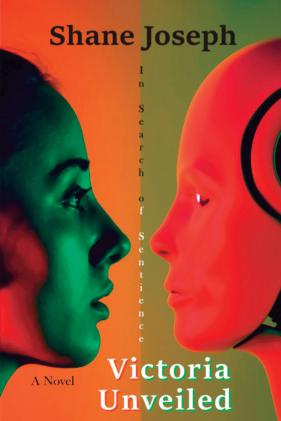

Go to this Goodreads link for advance reviews: https://www.goodreads.com/book/show/213128272-victoria-unveiled
Black Moss Press, 2022
Essay by Prof. Miguel Ángel Olivé Iglesias. BEd, MSc
Cuban President of the Canada Cuba Literary Alliance
General VP of the Canada Caribbean Literary Alliance
Author, Poet, Writer, Editor, Lit Reviewer, Translator
The heartfelt book Fathers & Sons (Black Moss Press, 2022) is an aweinspiring testimonial document to the experience aptly outlined on the book’s back cover, “that loving our fathers is a sacred blessing, a blessing to be loving and to thereby recognize that we too are loved.” Richard Grove, Don Gutteridge and John B. Lee brush with thick, solid strokes upon a theme they know and we know dwells in the space where “… much has been written about the relationship between fathers and sons.” Yet, their penmanship leads them brilliantly across that space to “…celebrate the entire grumble of the men who were the exact fathers of these particular sons.” The three great poets show us their understanding of such “instants” in life, which may be filled with “this undeniable tension between loving and hating” as Lee claims, and with a continual search for the right (always long) passage, to walk proud and satisfied along it towards the labyrinth’s exit.
Richard Grove opens the book. The title he gave to his section, The Burden of Loving, seems confusing at first but its oxymoronic feel helps us start to decode the why of the title. Thus we walk into a group of pieces filled with wit, humour, manifest objectivity despite the subjective character of the poetic pursuit. An example where Grove depicts some of his father’s characteristics using a bit of irony and humour is “Too Stubborn to Meet God at the Pearly Gates.” Let’s read a fragment from the poem:
I imagine God was waiting for father for some weeks or even months but father was too stubborn to meet him at the pearly gates.
“A Conversation Looking in the Mirror” is sad, sweet and presents us with a riddle-like idea that goes both ways: the son who wants to look like his father (“Just how much should I fine tune myself to be more or less like you?”), a father who will have to accept the certainty of genetics (“They broke the mold. You are stuck with me just the way I am.”). The poem is a modest tribute too; an element immediately detected in the line “the earnest sensibilities of work ethic that I gained from you,” which made me remember my own father and his lifelong dedication to work, study, reading, learning, and for his unyielding ethics despite context or circumstances.
I was particularly touched by a poem that is both simple and deep. Motivated by previous readings, Grove creates a wonderfully sustained metaphor anchored in the likening of two realities, bows and arrows–progenitors and offspring. A brief, inquiring piece, “if I were the arrow” invites readers to answer the question posed by the poet himself. In a perfectly woven textuality, Grove blends for the sake of richness and intrigue bows, arrows, wind, flight and target.
The poem is a long interrogative sentence with no visible answer. Grove exploits what is known in stylistics as rhetorical question. Nevertheless, we might find at least clues to an answer (or answers) in the very intense emotions of the poem and in the information that we collect, believe it or not, from the poems as a cohesive whole. “if I were the arrow” flies and pierces and addresses, sharp-end unabashed, ancestral, logical themes like origin-destiny, determination (“i fought, swerved and swayed”) against odds (the wind), and achievement (“i on this long piercing flight hit the target). We pick a sense of pride in those words, as well as an interesting spin of humour and mystery in the doubt planted by the poet with “who was.”
My next poem approaches the idea of affection from a highly considerate, tender, objective-subjective stance. The poem “The Burden of Loving” (the section’s title) is an evident confession of love and acknowledged responsibility, of seemingly conflicted feelings lancing the poet’s heart.
The poem starts with a simple sentence, “I love.” It means, to me, that the poet is making a clear, unambiguous statement: he does love; there should be
no doubt about it. From that position of conviction and faith, he then symbolically speaks to his father and reaffirms his love using an emphatic adverb, always. The poet comes clean and admits how those words of love stayed in the untold stage; they only flickered in his mind.
Once more, Grove resorts to the effectiveness of rhetorical questions and proceeds to re-emphasize his love. The end of the poem leaves readers with the gentle compensation and liberation found in the poet’s final proclamation of fortitude. One more thing, we see there are conspicuous blank spaces left unused in lines two, twelve and the last one. This might be interpreted, perhaps, as a token of the separation/distance/divide the poet suggests there was between him and his father. Whether this is intentional or not, stylistically shaded or not, in the end the poem stands as a beautiful make-up talk:
Grove’s awe-inspiring, formidable poem “The Sleep” made me tremble, and in the trembling, he made me recall one of my favourite poems, “O Captain! My Captain!,” by one of the greatest poets ever, Walt Whitman. Read fragments from Grove’s “The Sleep”:
Sleep dear king, now at your leaf-fallen years of swaying amber grass you are in preparation for the timeless slumber, at the threshold of the great sleep…
Grove calls his father “sovereign,” “dear king” and speaks of “walls of permanence,” “timeless slumber” and “the great sleep.” Somehow, the poet anticipates/desires a new kingdom for his father once he crosses the threshold, where he can rest eternally.
Don Gutteridge’s section, He Soared on Wings the Ice Gave Only to the Young, is a testimony of the poet’s feelings and experiences he accumulated about his father, other parallel stories running beside them. Undoubtedly the keeper of memories I have claimed he is, Gutteridge chronicles personal incidents that make up his life, mostly as a child/teenager.
“Injustice” is an example where innocence and excitement commingle with perplexity at the adults’ disciplinary stances:
… my Dad, nearby, accused me of hurting my best friend, marched me home and spanked me for the first and only time, and I didn’t know which was worse: the spanking or the injustice.
“… and I wish the day would last forever” is the last line in the poem “That’s How It’s Done.” It summarizes in my view the spirit of the poem and the spirit of the affectionate bond being built between father and son, based on an activity kids love so much.
Gutteridge is an icon of poetry. His poetry—whether its themes are fathers, grandfathers, wife, sons, grandsons, family, friends, acquaintances, events, etc. or not—still leaves that nostalgia of the past and that precision of remembrance not every poet is gifted with.
The Lonesome Postmaster of Antarctica is the third and last section in Fathers & Sons. John B. Lee is the poet who now shares with us his fatherson experiences. The first thing of interest as we read his Preface for the section is what he confessed right off: “I shared almost none of my father’s interests and even fewer of his enthusiasms. He was a farmer by birth and vocation…. I loved and admired him, and for a short while in my youth I entertained the idea of pleasing him by aspiring to become a vet…” Those were Lee’s clashing sentiments at the time, the struggle between complying with the life he was born into and following the call of the muses. “Listening to My Father” reflects that kind of child fascination for his father (fragments):
Sometimes as a boy from the bedroom above them I would hear my father’s voice droning through the floorboards an indecipherable sound as it is when wasp wings are cooling a hive in the heat
The first stanza depicts Lee’s recollections. He weaves exquisite imagery to explain, in his unique style, how he felt (“an indecipherable sound as it is when wasp wings are cooling a hive in the heat”). The sentence “wondering why it was only he I heard” proves to me that Lee’s father had a strong presence and an unquestionable influence in his life and his childhood.
“How Do You Deal with Things That Cannot Be Helped” is a poem that confirms the synergy of Fathers & Sons. For Grove, his universe shatters in his awareness of his father reaching a point of no return and the weakness that sets in when age and illnesses crush down; for Gutteridge, he wished his day with his father to last for always; now for Lee, he wishes he could go back in time… This piece brims with pride and childhood enthusiasm about the adventures he is having. It also mirrors some of the things the poet would have done differently looking at the experience from a temporal distance, with a more mature acuity.
While reminiscing, the poet continues to knead words and sentences into fresh images. Note that the phrase “… emerging like wingless imago we shaved in cold water…” carries the simile “like wingless imago”. Lee is an expert at crafting similes and seems to be fond of them for their power to bring realities together.
I call the readers’ attention to the fact that an imago, entomologically speaking, is an adult insect; and in psychoanalysis, it is “an unconscious idealized mental image of someone, which influences a person’s behavior.” Therefore, we can safely comment that both meanings overlap (contextual-physical, referring to the place they are, a fair; mental-ideal, referring to Lee’s father influential weight), given the context where they are and the polysemantic character of words, which gives the poet free latitude to sculpt and re-sculpt them.
The clashing dilemmas I mentioned at the beginning of my essay about Lee’s section (I said that he was conflicted between becoming a vet to please his father’s own aspiration and harkening to the muses’ call), recur in our next poem. Precisely the poem that entitles Lee’s section, “The Lonesome Postmaster of Antarctica,” revisits those dilemmas.
With time elapsing—racing away—and age heaping up in our bodies and souls, the usual, apparently unshakable structures of our lives and contexts start to weaken. All of our reality begins a down-hill process marked by sickness or the impossibility to do efficiently what we used to do without breaking a sweat. Lee’s poem “Just Two More Things …” is about that rearrangement of our personal-social-mental geography (fragments): as time is sometimes cruel to bones I’ve had to learn the lesson of pain in others…
I must conclude but I want to do it by quoting Lee’s closing poem. Only five lines long, it shines as a tribute to ancestry in the mists of the past. It gazes into those mists and returns to explain our presence on earth today:
“The Hour of Your Making” the hour of your making is there in your great-great-great grandfather’s arms in that loving darkness in a distant night
If my words have not sufficed to ignite “the light that candles the mind” and offer readers a helpful discernment of Fathers & Sons, published by Black Moss Press in 2022 and authored by three greats of contemporary Canadian poetry, then let’s have the best finish by re-quoting John B. Lee’s words in his Introduction to the book. They summarize, better than any other comment or opinion, what high winds, undercurrents, whirlpools and comforting moments cross and re-cross the book’s spirit: “And so in this book we have the complexity, the ambiguity, the surety, the paradox, of the relationship between ‘Fathers & Sons.”


